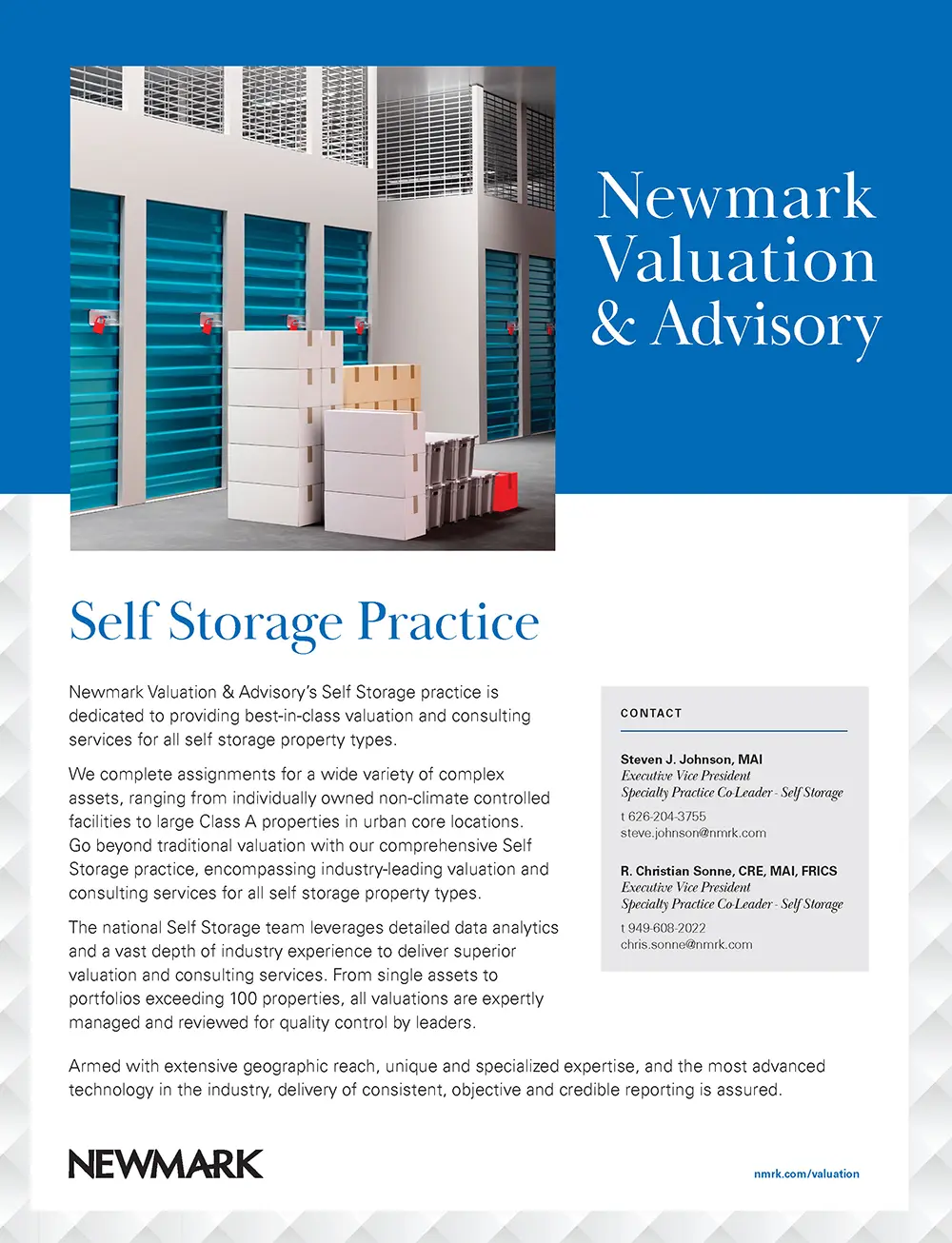How to enjoy our new magazine:
Just scroll!
Click or tap the table of contents icon in the menu bar to find any article.
Read any article by clicking or tapping the read full article button below each article intro.
Jump back to your previous browsing spot from any article using the menu bar or back to issue button.


Nokē ONE locks could reduce your tax liability by $40,000
In a recent survey, 87% of tenants said they prefer smart locks to traditional padlocks
Customers with Nokē have reported approximately 90% fewer burglary claims
5% OFF
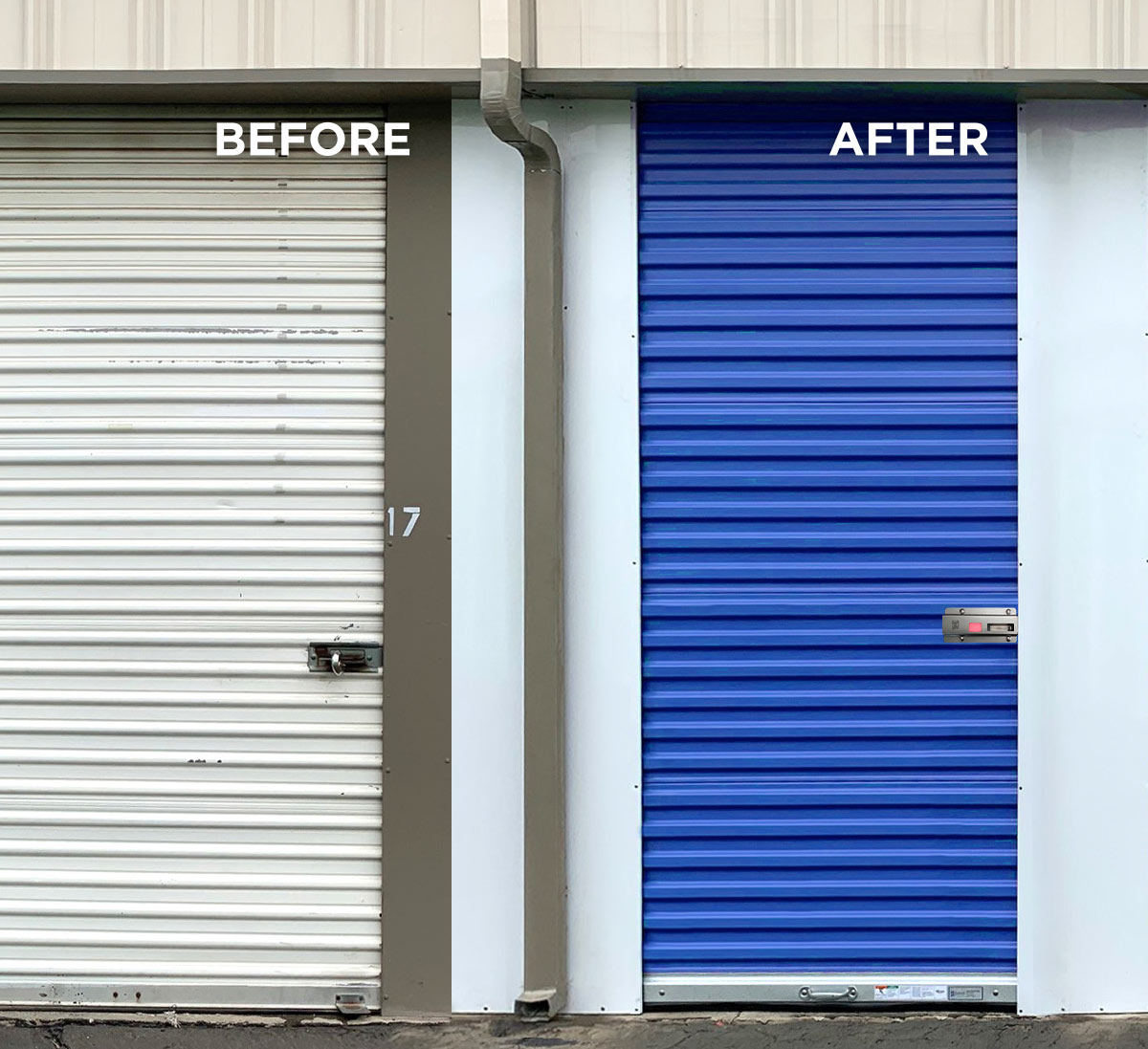
 The bottom-line impact of NOKĒ SMART ENTRY was a $300k investment for a $3M RETURN over 18 months.”
The bottom-line impact of NOKĒ SMART ENTRY was a $300k investment for a $3M RETURN over 18 months.”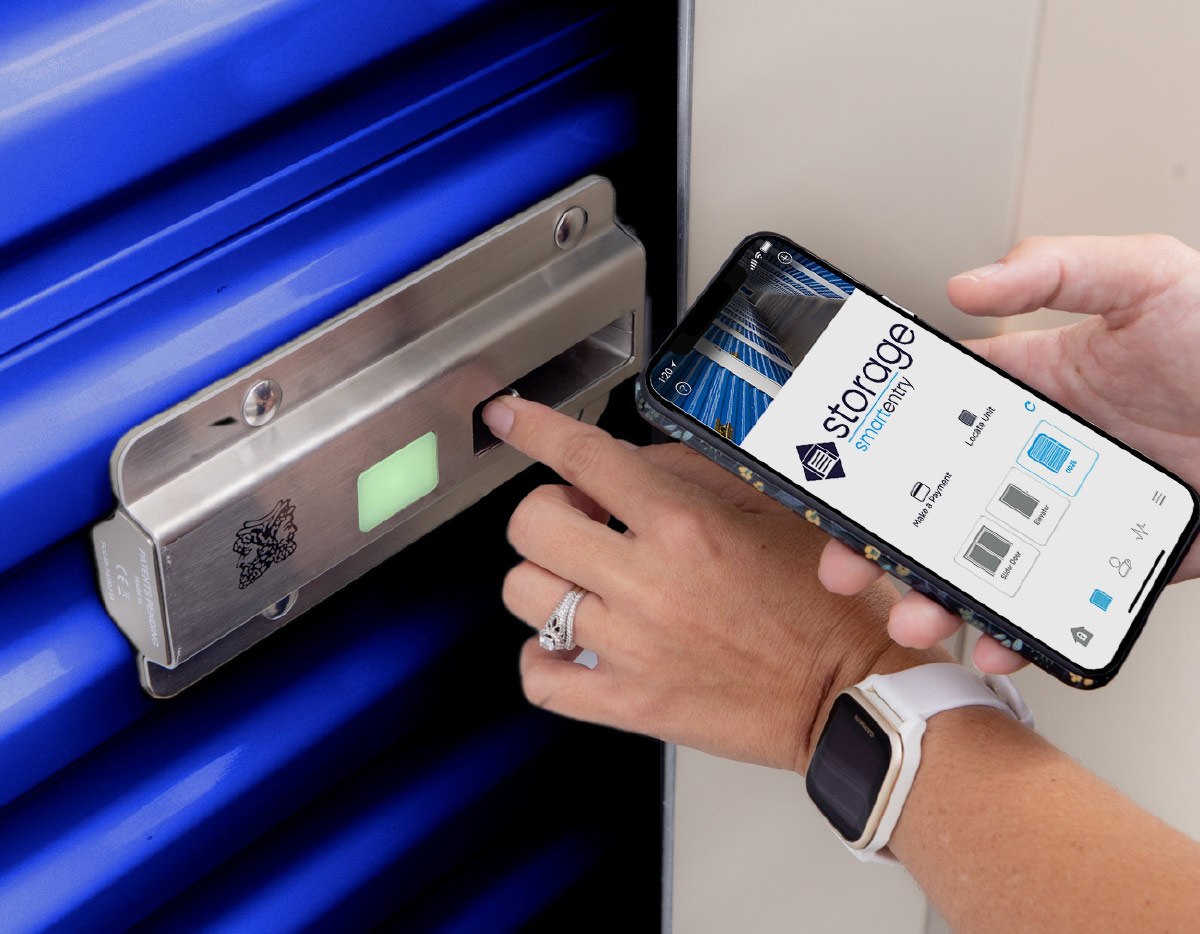

-
Host A Blood Drive And Save LivesPage 14
-
Developing Your Employees’ Leadership SkillsPage 16
-
Keeping Homeless Tenants From Living In UnitsPage 18
-
Chatbots And AI In Self-StoragePage 20
-
What Factors Determine A Facility’s Class?Page 52
-
Using Excess Land For Uncovered Vehicle StoragePage 54
-
StoragePRO at FairfieldPage 56
- Chief Executive Opinion by Travis Morrow 6
- Publisher’s Letter by Poppy Behrens 9
- Meet The Team 10
- Women In Self-Storage: Amy Amideo by Erica Shatzer 24
- Who’s Who In Self-Storage: Charles Plunkett by Erica Shatzer 29
- StorageGives 69
- Self Storage Association Update 71
- The Last Word: Noah Springer 72
For the latest industry news, visit our new website, ModernStorageMedia.com.

see self-storage operators trip over dollars to pick up dimes all the time. I’ve done it too. Just because something may seem expensive up front, the long-term benefits may often outweigh the initial investment. It’s easy to NOT spend money, but it’s not always wise.
He’s also the president of National Self Storage.

-
PUBLISHER
Poppy Behrens
-
Creative Director
Jim Nissen
-
Director Of Sales & Marketing
Lauri Longstrom-Henderson
(800) 824-6864 -
Circulation & Marketing Coordinator
Carlos “Los” Padilla
(800) 352-4636 -
Editor
Erica Shatzer
-
Web Manager / News Writer
Brad Hadfield
-
Storelocal® Media Corporation
Travis M. Morrow, CEO
-
MODERN STORAGE MEDIA
Jeffry Pettingill, Creative Director
-
Websites
-
Visit Messenger Online!
Visit our Self-Storage Resource Center online at
www.ModernStorageMedia.com
where you can research archived articles, sign up for a subscription, submit a change of address. 
- All correspondence and inquiries should be addressed to:
Modern Storage Media
PO Box 608
Wittmann, AZ 85361-9997
Phone: (800) 352-4636
appy New Year! As we step into 2024, we are excited to announce that the new MSM Store is open for business!
As you may know, for more than 40 years Modern Storage Media has been the voice of the industry and the most trusted source for self-storage news and insight. In keeping with that tradition, we have launched our new e-commerce website Shop.ModernStorageMedia.com.
The new site, powered by Shopify, brings together all MSM’s current publications, both books and subscription magazines, in one convenient, mobile-friendly location. On the new site, visitors will find MSM’s most popular subscription-based offerings, including Messenger, Self-Storage Canada, and Self-Storage Now. In addition to its own publications, shoppers can also pick up books by the likes of Carol Mixon, Jim Ross, Marc Goodin, Jon Dario, Michael Rotondo, and others.
As an added feature, the new store is searchable by keyword, and it allows shoppers to view items by price or popular collections, such as Construction, Development, Operations, Legal, and Marketing. Other popular MSM publications found in the new e-commerce website include the Almanac, Expense Guidebook, Development Handbook, RV & Boat Storage Development Handbook, and Law & Storage.
The store will be managed by Carlos “Los” Padilla, MSM’s new Sales & Circulation Manager. Padilla is also a self-storage operator with a technology background, giving him insight into both e-commerce operations and the self-storage industry.
Visit Shop.ModernStorageMedia to shop online, or just click through to the store from the main MSM menu.

Publisher

 As we step into 2024, we are excited to announce that the new MSM Store is open for business!
As we step into 2024, we are excited to announce that the new MSM Store is open for business!
appy New Year! As we step into 2024, we are excited to announce that the new MSM Store is open for business!
As you may know, for more than 40 years Modern Storage Media has been the voice of the industry and the most trusted source for self-storage news and insight. In keeping with that tradition, we have launched our new e-commerce website Shop.ModernStorageMedia.com.
The new site, powered by Shopify, brings together all MSM’s current publications, both books and subscription magazines, in one convenient, mobile-friendly location. On the new site, visitors will find MSM’s most popular subscription-based offerings, including Messenger, Self-Storage Canada, and Self-Storage Now. In addition to its own publications, shoppers can also pick up books by the likes of Carol Mixon, Jim Ross, Marc Goodin, Jon Dario, Michael Rotondo, and others.

 As we step into 2024, we are excited to announce that the new MSM Store is open for business!
As we step into 2024, we are excited to announce that the new MSM Store is open for business!
The store will be managed by Carlos “Los” Padilla, MSM’s new Sales & Circulation Manager. Padilla is also a self-storage operator with a technology background, giving him insight into both e-commerce operations and the self-storage industry.
Visit Shop.ModernStorageMedia to shop online, or just click through to the store from the main MSM menu.

Publisher
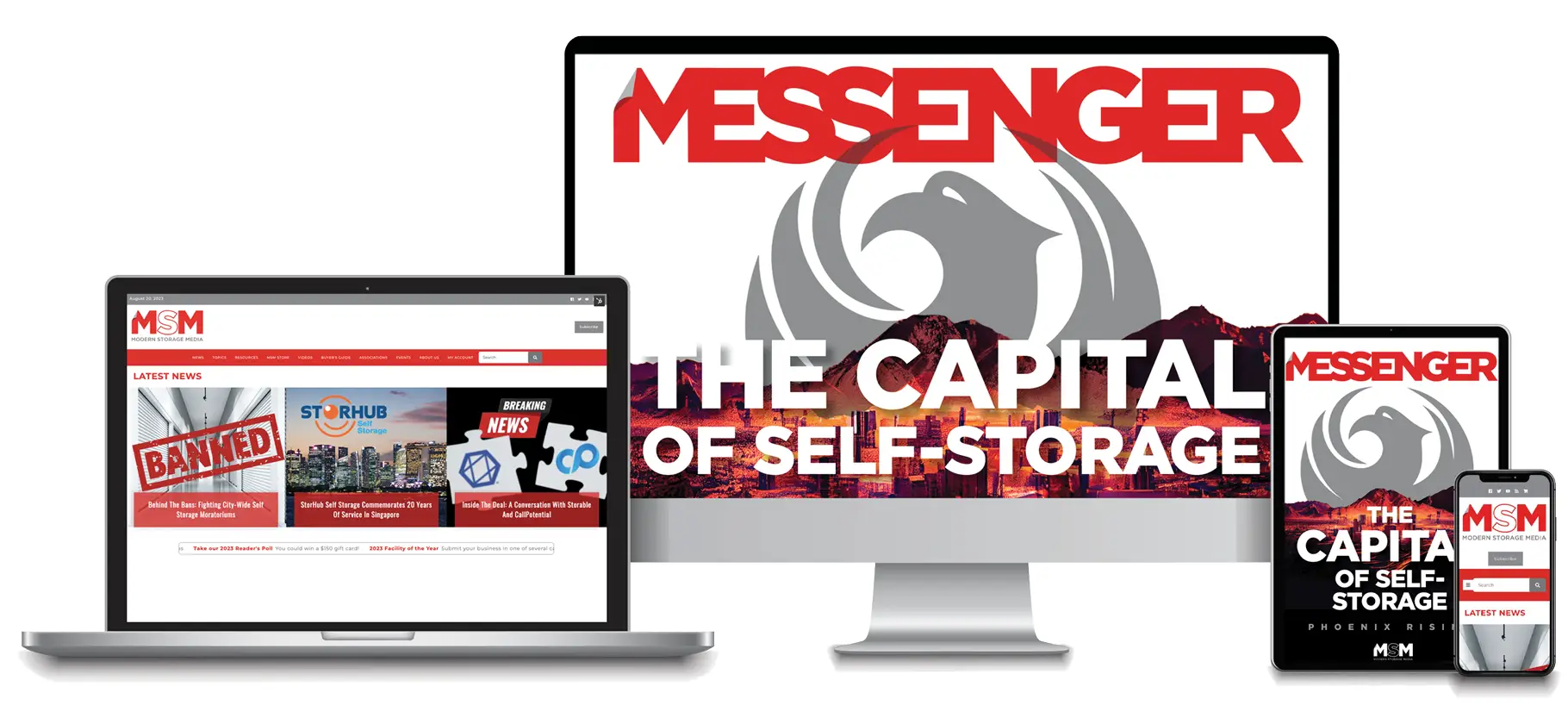
- Breaking news updated daily
- Real-time sales and acquisitions updates
- A newly redesigned calendar of events
- Enhanced promotional opportunities for advertisers
The website also enables readers to submit news, events, and article ideas. Don’t forget to browse the MSM Store for dozens of exclusive, storage-specific publications, including three of the industry’s most trusted resources: the annual Self-Storage Almanac, The RV & Boat Development Handbook, and the annual Expense Guidebook. New publications are frequently added to its extensive list of offerings!




Modern Storage Media



Messenger

alen is a child who loves being active and playing sports; he just wants to be a child like any other. However, Jalen was born with sickle cell disease (SCD), a disease of the blood that requires regular blood transfusions.
Jalen’s story is just one of the many stories highlighted on the American Red Cross website of people who survive or have survived thanks to blood donors.
Last fall, the American Red Cross posted they are facing a national blood shortage. The reasons, their website explains, are many.
What does this have to do with the self-storage industry? Red Cross blood drives are an excellent way to reach out and give back to the community, according to Stacie Maxwell, vice president of marketing and training for Universal Storage Group in Atlanta, Ga. “It’s really a good event to do, very simple,” she says. “The Red Cross does most of the set up and work; we just help with traffic flow.”
Some events, such as the blood drives, serve a dual purpose. “We may do a blood drive as one of our days of service to the community,” says Maxwell. “We always have a good traffic flow for those.”
Of course, the effort assists the community first and foremost, but also achieves what other less serious events do–getting people on the property and maybe putting the facility at the top of people’s minds. “Hosting is great for generating traffic,” she says. “Just creating an event that shows we care, but if it’s set up properly, we can also show off the property as people are waiting.”
Maxwell says the company has one property in Florida that sets up several successful blood drives every year. “Events have proved to be phenomenal marketing for the property,” says Maxwell. “They have all kinds of events all summer long on the property and they’re all very successful. Some of those events are blood drives.”
USG’s events are all well-publicized.
Todd Amsdell, president/CEO of Compass Self Storage in Cleveland, Ohio, says his company has rarely conducted blood drives on their properties. “We had an employee who had a relative that needed blood, and the event was very successful,” says Amsdell. That event wasn’t publicized to the community, but he says, “That might be a good publicity tool for the property.”
As described in Jalen’s story, there are many reasons a person in the community may need blood. “Patients undergoing cancer treatments often require blood or platelet transfusions during their treatments. In fact, nearly half of all platelet donations are given to patients undergoing cancer treatments—a disease all too familiar to millions of Americans and their families. Approximately two-thirds of all children diagnosed with cancer will require a blood transfusion at some point during their treatment,” the Red Cross said in a statement.
Some of the patients who need blood may require up to 100 units per year. The American Red Cross supplies 40 percent of the nation’s blood supply.
The Red Cross says there are many reasons for the current shortage, “There are several reasons for the drop in donor turnout—one of the busiest travel seasons on record, back-to-school activities—and back-to-back months of almost constant climate-driven disasters. The Red Cross is working with hospitals around the clock to meet the blood needs of patients but can’t do it alone. The need for blood is constant. Every two seconds, someone in the U.S. needs blood—an often-invisible emergency that the rest of the world doesn’t see.”
- Work with your Red Cross representative throughout the process.
- Set the date well in advance, avoiding scheduling conflicts with other major events in your area.
- Select a location, preferably a large, open room with space to ensure donor interviews are conducted in a private and confidential manner. If your facility doesn’t have a large separate enclosed space, such as a conference room, it can be an outdoor event, just space the tables and chairs far enough apart so donors can feel their privacy is secure. Maxwell says it’s best to have people moving through different areas of the property so they can see the amenities the property has to offer.
- Recruit volunteers to help sign up donors. You’ll also want volunteers to help the day of the drive to ensure it goes smoothly.
- Recruit donors with the help of your volunteers. Recruiting is most effective when done face to face, and you can reach more people by spreading the effort among your team than doing it alone. Publicize the drive through your community contacts and email lists.
- Sign up donors using the Red Cross online scheduling system; this will help you keep track of your signups and offer donor reminders and thank you email templates.
- Engage community partners to supply donor incentives, thank you gifts, and treats such as extra cookies or pizzas for your donors and volunteers. Maxwell says they always offer a prize drawing. Once someone has won the prize, this can be used as publicity on social media.
- The facility will need to provide chairs, which Maxwell says can be rented, as well as a few tables. The Red Cross will bring some tables and chairs, but it is helpful to supplement what they bring.
- Arrive early to meet the Red Cross team; they will arrive up to two hours prior to the first appointment to set up.
- As Maxwell points out, their staff assists at the refreshment and prize tables, as well as helping with traffic flow onto the facility.
- Send reminders or make calls to scheduled donors, especially those who miss their appointments.
- Manage the volunteer schedule so the registration and refreshments areas are always covered.
he main goal of a self-storage facility is to attain maximum occupancy through sales, but many owners and executive managers don’t realize that selling the job to their employees is just as important as selling units to a tenant.
One important aspect of hiring and retaining excellent self-storage managers is building leadership skills in those employees.
“We have to first hire the right people and then allow them ownership of the job,” says Ann Parham, CEO of Joshua Management, a division of The Parham Group in Bulverde, Texas.
Surveys show that hiring the right people for the job is the first step in instilling leadership and the second is allowing employees the autonomy to perform that job. A recent Gallup Poll showed that 58 percent of employees surveyed responded they would be happiest in a job that allows them the autonomy to do what they do best.
Hiring and instilling leadership skills and autonomy will ultimately make your employees happier and strengthen the retention rate.
Here are five steps you can follow to foster leadership skills in your employees:
1 Hiring – Good self-storage managers are “people people,” says Parham. “We started doing personality type surveys to find the people who are good salespeople and good customer service people,” says Parham. “We can put a lot of money into a facility, but if we aren’t hiring the right people for customer service, it won’t work. We can train people on the computer and how to do leases, but we can’t teach good customer service skills.”
According to Eddy, an employee management software company, employees who become good leaders also possess motivational qualities, integrity, empathy, confidence, the ability to be humble, good communication and problem-solving skills, as well as accepting accountability.
2 Training – Stacie Maxwell, vice president of marketing and training at Universal Storage Group in Atlanta, Ga., says instilling leadership in each employee is important, and for USG, it starts in the training process. “We instill leadership by showing them how to take ownership and by having them hands on in the training process,” says Maxwell. USG’s training process is implemented into four phases:
- Storage 101 – In this phase, new employees work through the basics of the processes, including completing leases.
- Storage 201 – In this phase of training, employees learn about revenue management, managing street rates and delinquent tenants, completing rent increases, selling product, and increasing sales, as well as the fundamentals of ROI.
- Assigning a mentor – At USG, each new employee is assigned an internal certified trainer to act as a mentor for 45 to 60 days. “This phase is all about marketing; we get them used to the product so they can sell,” says Maxwell.
The HR firm Eddy says assigning a mentor is one of the top ways to instill leadership in employees. “A mentor can guide the employees to improve as well as set an example,” explains Eddy’s website. The company also recommends allowing employees who have demonstrated leadership skills to eventually act as mentors to other employees.
- Auction training – The final step in the training process is teaching new employees all they need to know about the auction process. “All of our training occurs within the first 60 days, but there is continual training for everyone once a month,” Maxwell says. These training sessions are called “The Company Broadcast,” in which all employees participate via video conference.
Part of the meeting encompasses important personal announcements for employees such as birthdays, anniversaries, and birth announcements. “Employees are encouraged to share anything important,” says Maxwell. “This segment helps everyone feel like they are part of the company, a team.”
Managers and employees then share issues and other business topics. Finally, there is a training segment in which trainers refresh employees on topics that may be causing concerns within the company.
3 Encourage employees to take ownership – All successful experts within the self-storage industry say this is one of the most important steps in instilling leadership in its employees. “We try to enable our managers to take ownership in the property,” says Parham. “We have one facility in a small town in which the town actually thought our managers owned the facility and we just let them think that.”
Parham adds that it’s important employees don’t feel like “monkeys behind a desk” and says employees at her company are involved in decisions such as budgeting and expenses. “We’ve hired managers from other companies who say they never had involvement in decisions at their former jobs,” says Parham. “It’s important to employees to have that. Some companies make their employees memorize a sales script; we don’t do that because we don’t want robots. People all have different needs and approaches.”
They do not micromanage, which allows employees to make more decisions on their own and instills leadership skills. “We also believe if we make money, our employees make money,” says Parham. “That’s another way they feel they are taking ownership of the property.”
Anne Mari DeCoster, president of Kingdom Storage Partners and Self Storage Investing in Scottsdale, Ariz., agrees in allowing employees to take ownership through participation. “I promote open discussion and debate,” says DeCoster. “Once we make a decision, we also ask for buy in from employees on the decisions.”
Todd Amsdell, president and CEO of Cleveland, Ohio-based Amsdell Companies, which operates facilities as Compass Self Storage, says it’s all about creating a company culture that fosters ownership. “We tell our employees they need to do the right thing for the customer and the company and to run their facility as if they own the company,” says Amsdell. “At the end of the day, we would rather them be a part of the process and share in the success.”
4 Assign projects – Another tool DeCoster uses in helping to instill leadership is identifying an employee’s strengths and assigning special projects. “We give them an opportunity to lead through leading a project and seeing how they demonstrate communication and other qualities,” says DeCoster. “We always circle back and hold people accountable for their projects, but it’s those people who approach me before I have to ask who are rising in leadership skills.”
5 Provide feedback and expect accountability – DeCoster says it’s very important to help employees develop leadership skills by providing feedback. “If we have something that hasn’t worked as it should or we aren’t making numbers, we will tell the employee what happened and if that’s what they intended to happen,” she says. “This approach helps them think through their decisions and the impact of their decisions.” DeCoster cites an example of someone coming into the facility and reporting not feeling welcome. “We will tell the employee what happened and ask if that was the desired outcome, and we then talk about how they can do things differently,” she says. “We also keep in mind to praise publicly and coach privately.”
Amsdell also says accountability is important. “We tell our employees to go with their gut about what is the right thing. They might make a mistake, and we also think it’s better for them to talk about it and own up to it rather than take a chance it wasn’t the right thing to do.”
ccording to information from the U.S. Department of Urban Planning and Development, homelessness has increased by more than 12 percent in 2023, for a total unhoused population of 653,104 people.
With inflation to blame for the double-digit increase, homelessness is a growing problem the country faces, and it can become a problem for a self- storage facility if the homeless try to make a unit their home.
M. Anne Ballard, president of marketing, training, and developmental services for Universal Storage Group in Atlanta, Ga., has dealt with the issue several times during her long career in the industry.
“It’s an unfortunate situation and probably will not get better,” says Ballard of the homeless issue in America. “It’s really an issue that is increasing in major cities, especially with so many migrants being taken into cities.”
Ballard says there’s several steps your facility can take to help prevent homeless from setting up camp in your units:
- Make sure you’re covered in your lease. As with many areas of your business, your first line of defense is the wording in your lease. “Make sure there is wording in your lease saying there is no living on site or habitual occupancy, even during the day,” says Ballard. “It’s also good to include that only storage items are allowed in the units.”
- Note the red flags. When a potential tenant comes in and they haven’t listed a home address, employment, or other source of income, it’s a red flag that the applicant may be homeless and trying to find shelter in a unit. “If they don’t have a credit card, address, or employment, you can refuse to rent to them,” says Ballard.
- Meet your tenants. Even if your facility has no contact leasing, make sure your managers are following up with new tenants, calling the number they provided. “Our managers call and make sure everything went well with their move-in,” Ballard says. This lets tenants know you’re not only providing customer service but are aware of what’s happening on the premises.
- Conduct daily walk-throughs. This is an important line of defense for USG’s properties. USG managers are required to do a cursory walk-through of the property daily, checking units and locks and greeting tenants who happen to be on site (she says it’s OK to be a little nosey when making small talk by asking what they’re doing). “If tenants see managers out on the property, they are less likely to be doing things they aren’t supposed to be doing,” says Ballard. One of the biggest mistakes facilities make is not securing vacant units with locks. “All units that aren’t occupied should be secured, which not only prevents people from living in the unit, but also prevents tenants from deciding to claim an unrented unit they aren’t paying for,” says Ballard. While walking the property, red flags include seeing a tenant on the property every day or often and seeing power cords running into units. Another sign of someone living on the property is seeing the hallway lights on when the manager comes in. Ballard advises facilities to also check bathrooms frequently. “Of course, if someone is living on the property, the bathroom is their only source of water and facilities, so make sure to keep an eye open there, too.”
- Monitor the security systems. Your final defense in monitoring your property includes paying attention to the gate security and door reports. Note any tenant who is coming and going daily or on a too-frequent basis. If a tenant is going to their unit every day and not leaving, it could be a red flag they are staying in their storage unit. Ballard adds that also monitoring the camera system can alert managers to someone living in a unit.
Though many chronic homeless people deal with mental health issues, anyone can become homeless. “There are people who become homeless because of medical bills,” says Ballard. “While we have a job to do, it’s best to remember these are people and we should be compassionate. I believe we need to be empathetic with them while not terrorizing them.”
She says it’s a good idea for managers to keep a list of resources for homeless on hand and offer these resource contacts. “Explain to them that we must run the facility according to the lease agreement and offer them resources.”
Next steps include:
- Ask the tenant to leave. Tell them you are terminating their lease.
- Mark their file. Make sure the conversation is documented within their account; mark their digital and/or paper files, notating that the lease is terminated and no future payments should be taken.
- Contact the police as a last resort. “Most people will leave voluntarily once they are discovered,” says Ballard. Law enforcement should only be called if the tenant is causing a disturbance, the manager feels threatened, or the tenant refuses to vacate the property.
f you are familiar with the world of self-storage, you know that convenience and customer satisfaction are their main thing. As with any other industry in recent years, technology has become increasingly vital. Among the latest innovations making waves in the industry are chatbots and artificial intelligence (AI). Understanding the impact of chatbots and AI in self-storage is indispensable for staying ahead of the competition and providing top-notch customer service.
For developers and investors, this translates to cost savings and increased profitability. With fewer resources dedicated to routine operations, there is more room for expanding and managing additional facilities, ultimately growing your self-storage portfolio. This expansion can lead to higher revenue streams and a more robust investment portfolio, appealing to institutional investors seeking profitable opportunities.
Customers appreciate the convenience of instant responses, which can lead to higher satisfaction and loyalty. For owners, operators, and investors, this means more repeat business and positive reviews, contributing to the success and reputation of your self-storage facility. Satisfied customers are more likely to recommend your facility to others, boosting your occupancy rates and revenue.
Selecting the right technology is very important for providing excellent customer service, streamlining operations, and ensuring data security. Ensure your chosen technology aligns with your long-term business goals, providing a solid foundation for future growth and development.
Proper training and integration are vital for preventing disruptions in your operations. When your staff is well-versed in using the technology, they can provide more efficient support to customers and troubleshoot any issues that may arise, resulting in improved customer satisfaction.
Personalization is not only about improving the user experience but also about generating valuable data for your business. You can fine-tune your services, promotions, and marketing efforts by tracking customer interactions and preferences, ultimately increasing your revenue and ROI.
- Customer Satisfaction: Track customer feedback and reviews to evaluate the impact of chatbots and AI on customer satisfaction. A positive trend in these metrics indicates that your investment is paying off. Remember that customer satisfaction should be at the forefront of your goals, as it directly impacts your facility’s reputation and profitability. Satisfied customers are more likely to become repeat customers and refer others to your self-storage facility, driving steady revenue growth.
- Operational Efficiency: Monitor the time and resources saved by using chatbots and AI in self-storage. Are your staff spending less time on routine tasks? Are operational costs decreasing? These are critical indicators of success. Operational efficiency is not only about saving money but also about providing consistent service and maintaining a competitive edge in the industry. Efficient operations allow you to reallocate resources to other business areas, such as marketing or facility improvements.
- Rental Conversion Rates: Analyze how chatbots and AI affect your rental conversion rates. Are more website visitors converting to customers? Are you seeing an increase in reservations and rentals? These rates directly reflect your ability to turn potential leads into paying customers. A higher conversion rate means your chatbots and AI are successfully guiding prospects through the rental process, leading to increased revenue and occupancy rates.

or nearly 30 years, the Arizona Self-Storage Association (AZSA) has been strengthening the self-storage industry in Arizona by promoting professional business standards and presenting a unified voice on issues affecting owners/operators throughout the state. The association, which aims to engage, educate, and empower its members, has grown its membership to approximately 500 facility and vendor members since 1996. And one of its former vendor members began facilitating the association’s return to its roots in 2020.
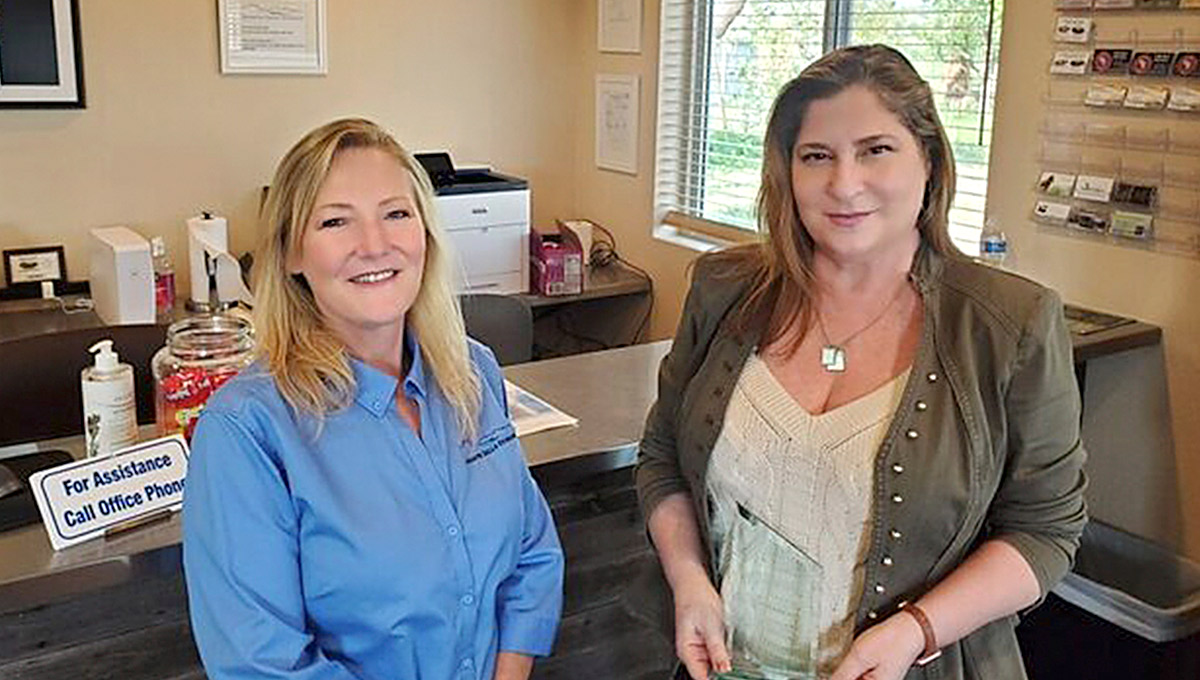



That volunteer experience proved to be a lifechanging event for Amideo, who admits she “wasn’t happy in finance,” which she calls a stressful and highly competitive industry. “Anne Mari DeCoster [former AZSA executive director] was taking a position elsewhere,” recalls Amideo. “She thought I’d be a good fit for it, and I was ready for something new.”
For Amideo, “watching industry competitors giving each other advice” at AZSA’s 2019 conference was an eye-opening incident. She realized the association—and the entire self-storage sector—was formed by cooperative, helpful individuals who want to see each other succeed, even if they are competing for market share, and make charitable giving a priority.
With DeCoster’s endorsement in February 2020, and admiration for the self-storage industry’s sharing nature, Amideo made the decision to join the Arizona Self-Storage Association as the interim executive director in March 2020.
Though initially apprehensive about the position, she says the entire “incredible” AZSA board “rallied around” her; their support enabled her to help maneuver the association and its members through the uncharted waters of the COVID-19 pandemic.
Despite the chaos, there was one silver lining: “I had a year to figure things out,” says Amideo, who remains appreciative of the assistance she received from the AZSA board members during that adjustment period.
Last year, through industry collaboration, Amideo developed and introduced a new, three-tiered corporate sponsorship program for the AZSA: Turquoise (the sponsorship level that offers the most exposure for sponsors), Silver (the middle ground), and Copper (an entry-level option for those not yet ready to commit to a major sponsorship). AZSA currently has five turquoise sponsors:
- Caliber Metal Buildings
- Crescendo Self Storage Management
- MiniCo Insurance Agency, LLC
- TLW Construction
- U-Haul International
Corporate sponsors enjoy comprehensive marketing opportunities at the association’s various events. AZSA also offers numerous non-sponsorship advertising options through its websites, newsletters, and events. For additional details, visit www.AZselfstorage.org.
One of the key changes Amideo implemented for that year’s conference was utilizing a separate but connected exhibitor area and attendee area. The exhibit space was designed to have easy access to the attendee area; they were divided by an airwall with doors leading in and out of both areas. She also ensured that the trade show was accessible to attendees throughout the entire conference, with dedicated exhibit time on both days as well as open accessibility.
Amideo has been responsible for executing several new initiatives as well, including “Ruralpolooza” (see the Ruralpolooza sidebar for details); new corporate sponsorships (see the corporate sponsorships sidebar); “Project Hope,” an endeavor that aims to provide operators and managers with resources to pass along to their homeless tenants; new legislative efforts and the online “Legal Connection” with Jeffrey J. Greenberger, partner at Greenberger & Brewer, LLP; networking breakfasts; and townhall-style meetings within the eight regions of the state—all of which are enabling her to home in on the three main objectives of the AZSA’s mission statement (engage, educate, and empower).
In conjunction with Ruralpolooza, she is in the process of reinstating the association’s 20-plus-year-old district liaison program to give AZSA’s rural members a more prominent voice. It will be fully functional by the end of 2024. “While I was out meeting the owners and managers, I was also building relationships and seeing who might be a good fit for the district liaison position,” says Amideo. “It’s vital to have representation in parts of the state such as Flagstaff, Yuma, Lake Havasu, and the White Mountains. The main purpose was to have that local person who knew the people and the town well be an extension of the AZSA board. They would have much more influence on owners attending regional meetings, workshops, and networking events. When self-storage was a new industry, the board wanted to make sure everyone was aware of the laws and statutes and promote what was a novel idea then—collaboration. The board has always believed in strength in numbers.”
She goes on to say, “The district liaison will have direct access to a designated board member. This will now be a mentor role for the AZSA board member.”
Building on the hard work of long-time and former AZSA board members, Amideo is dedicated to engaging and empowering the next generation of self-storage professionals and AZSA members through the district liaison program and various in-person events that foster collaboration.
“AZSA has the direct line to what our regional issues are and the owners’ best practices to share with their communities and the state at large,” Amideo says about the association’s efforts to uphold collaboration. “It will give them a sense that they are part of something bigger, a feeling of community. It also helps everyone realize the importance of the association’s legal and legislative pillar. This is difficult to see on a daily basis, but it’s crucial when laws are being proposed that are unfavorable to our industry.”
Speaking of laws, Amideo mentions that AZSA has received a grant from the Self Storage Association (SSA) to fund a two-pronged bill that aims to incorporate a towing statute and a $5,000 liability cap into the state’s existing self-storage laws. Along with the SSA, Triadvocates, and Barb Meaney, AZSA and Amideo have been working with lobbyists to make these legislative improvements. “By June or July, we’ll know if it’s passed,” she says, pointing out that simply having a liability cap within a rental agreement or lease may not hold up in court, should a litigious tenant file a lawsuit. “We have a great operations manual and resources, including the Sales and Foreclosure Manaul, to help owners operate their business with peace of mind.”
Early on in her career as executive director of the Arizona Self-Storage Association (AZSA), Amideo decided to embark on a quest to meet AZSA facility members in the most rural areas of the state, many of whom were unable to attend the association’s events due to their far-flung locations.
She named her journey “Ruralpolooza” after the well-known, annual music festival Lollapalooza, which was started in 1991 by Jane’s Addiction band leader Perry Farrell as a multi-city venue for his band’s farewell tour. The word lollapalooza means “a person or thing that is particularly impressive or attractive,” but Amideo recalls Farrell saying that the festival was a vehicle of sorts for getting “back to the roots of music.”
“That always stuck with me,” she says, adding that the opportunity to visit AZSA members at their facilities was like returning to the roots of the association (hence the moniker) and would help her better cater to the needs of all its members—no matter their venue within the state.
“I took over a position that was held by Anne Mari DeCoster for over a decade,” Amideo says, “so there was that need to introduce myself in person. With COVID shutting everything down, this was the only way I could think of to introduce myself and let them know that AZSA was here for them during this pandemic.”
“I’m really excited about where we’re going!” Amideo says, adding that she has a strategic plan for 2024 to increase AZSA’s market share by 20 percent.
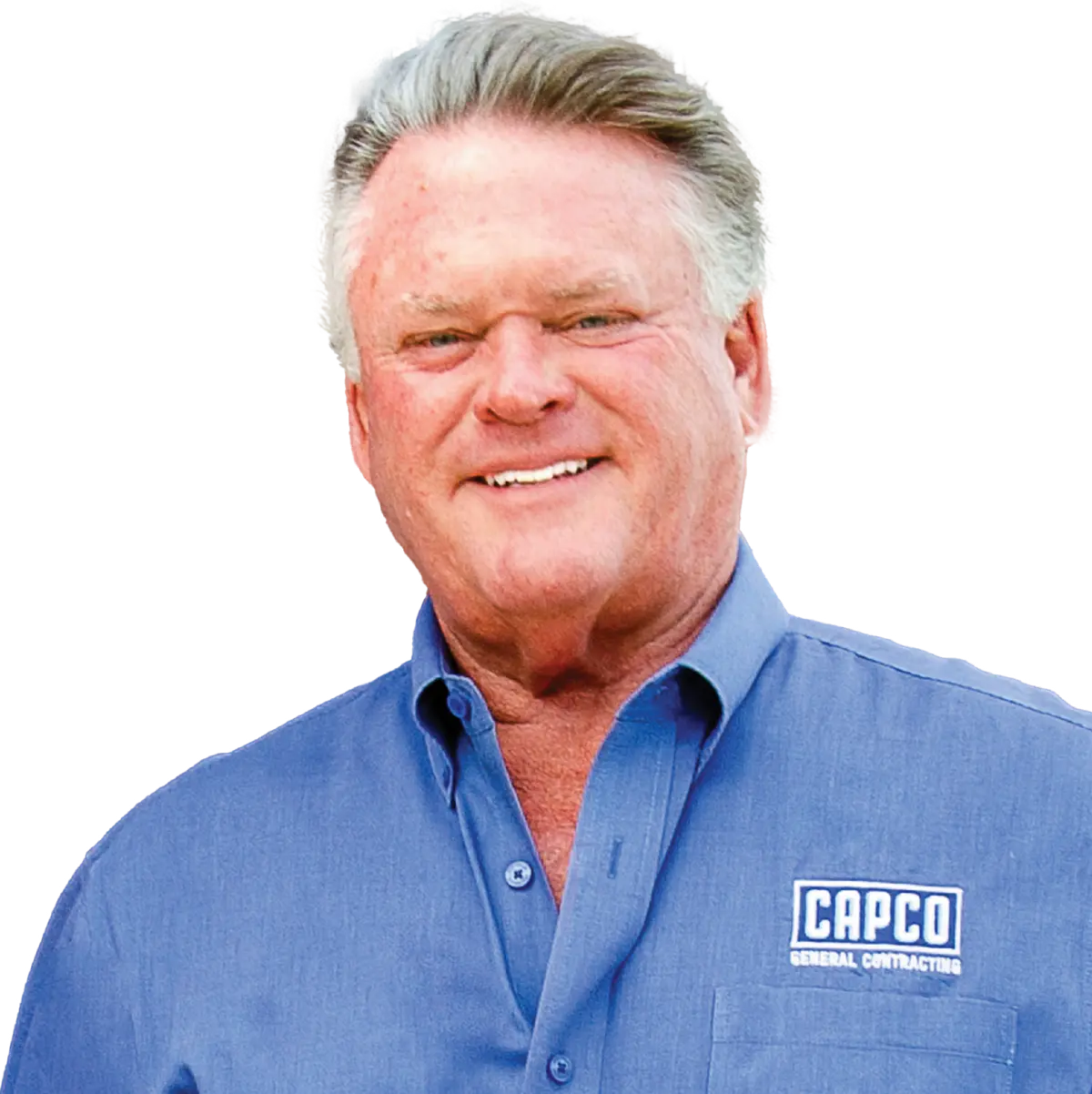
hen you’ve been in the self-storage industry for nearly four decades, you’re likely to learn priceless lessons about the business and how to weather any economic climate. That’s the kind of experiential knowledge Charles Plunkett, CEO Capco General Contracting and Capco Steel, Inc., who founded Capco Steel in 1985, brings to the table and candidly shares with new developers.
“With being in business for 38 years, there have certainly been many ups and downs,” Plunkett says. “I have been through so many cycles of economic growth and shrinking.”
And anytime there’s volatility, he’s asked one question on the regular: Is this a good time to build or develop self-storage?

- Interest rates are up “significantly.”
- The costs of building materials have escalated.
- Steel is more expensive.
- Shipping and delivery fees are higher.
- Labor costs have increased.
Although these statements are accurate, Plunkett points out that he’s been having the same discussion for 38 years. “Costs shouldn’t be the deciding factor. Costs will only continue to increase over time. They zig zag up,” he says, adding that any line item would create a stair-step graph. Even when costs decrease, “they never quite go down to where they were” before they increased.

All things considered, Plunkett says that potential developers should “assume it will never be less expensive than it is now. It’s difficult to time a ‘sweet spot’ without a crystal ball.”
Instead of wondering if costs and interest rates will recede enough to make their proposed projects more lucrative, or waiting around for better values that may never come about, he advises developers to determine whether the development would meet their minimally acceptable return on investment with the present-day pricing.
“It’s always a good time if the projected returns are there,” Plunkett says about building or developing self-storage. “Does it work today? If it will work today, there’s no reason not to move forward with it.”
What’s more, as Plunkett explains, “There’s aways upside to the business.” Populations, rental rates, and values all grow alongside construction costs.
For those seeking an industry average for cost analysis, Plunkett says, “We currently have projects with all-in construction budgets ranging from the low $70 per gross square foot to well over $100 per square foot. The average ranges that we see are roughly $75 to $90 per gross square foot.” These averages apply to projects they are building throughout Texas, as well as the lower Midwest and some along the East Coast and Southeastern U.S.
According to Plunkett, location can significantly impact costs in several ways. For starters, the cost of land will vary depending on the project’s location. Obviously, land within a primary market will be more expensive than land in a tertiary market, but the difference could make the project unfeasible.
“Location is a big factor in cost adjustment,” he says. “… if you are building in Houston, Texas, you have that regional cost. However, if you are building in New York City or San Francisco, those are two completely different circumstances. It could be as much as 50 percent higher, or even double the cost or more, to build in these areas. These costs are driven by cost of labor, unions, and many other factors. In my experience, there is always a parallel between the cost of construction and rents. Basically, this means that if you are building in an area where the cost of housing, cost of living, cost of land, and costs of construction are high, the rental rates in that area are also going to be high as well.”
And, as he knows all too well, some areas require extensive foundational work. “Across the country, there are many varying types of soil conditions,” says Plunkett. “Along the coast lines you can have sandy soil with the water table very shallow below the top of the soil, or bay mud that is not supportive of structures. You can have very rocky soil or even hard flint rock to deal with, or you can have highly expansive clay soils. All of these require different types of procedures to provide a suitable sub-grade to build on.”
He goes on to say, “The additional cost to repair the soil condition could range from an added $3 to $7 per square foot of gross building. So, if you are developing a three-story, 120,000-square-foot building, this could cost an additional $360,000 to $840,000 for your project depending upon the procedure necessary. If you are not aware of this potential expense, you may be in for a very big surprise.”
Building in phases is a strategy that has helped many developers get their projects across the finish line. Typically, phasing includes building a multistory, climate-controlled facility first, then constructing additional buildings as (or after) the first building leases up. Income from the climate-controlled rentals can be used to fund future phases.
When it comes to modifying the original design, Plunkett says to “tailor it to the market but really look at it” because the design may include unnecessary elements. As an example, he recommended that one developer redesign his project to include one multistory facility instead of two buildings. By doing so, they essential cut costs in half as fewer stairs, elevators, walls, etc. were required. Eliminating the covered, drive-thru loading bay also helped make the project pencil. Moreover, developers can dial back on the finishes and build less extravagant offices to save money; you can build an appealing property without going over the top with glitz and glamor.
“Temper the dream,” he says, adding that developers should question what’s driving the project. “What’s most important to the project? Be willing to compromise. Eighty percent of something is better than 100 percent of nothing.”
On another note, while it was previously considered more costly to build multistory projects, Plunkett states that the costs to build single-story and multistory facilities are comparative. Multistory facilities require elevators and stairs, but single-story facilities need more land, paving, site work to prep the earth, and cement slabs.
“Analyze the costs and demand,” he says. “Look at all the elements and how the costs compare to the revenue it will produce. There is a market for drive-up storage in most markets, but climate-controlled storage produces more revenue.”
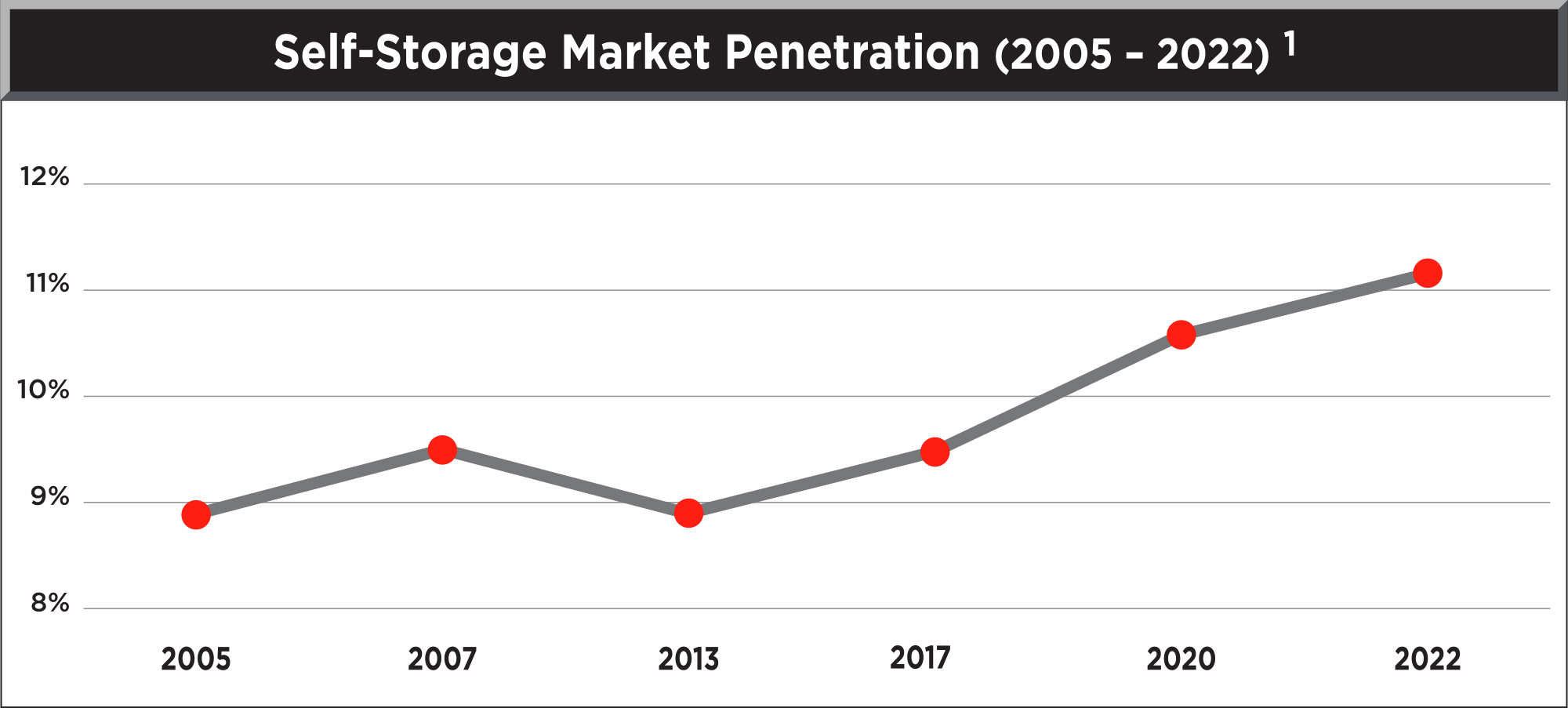


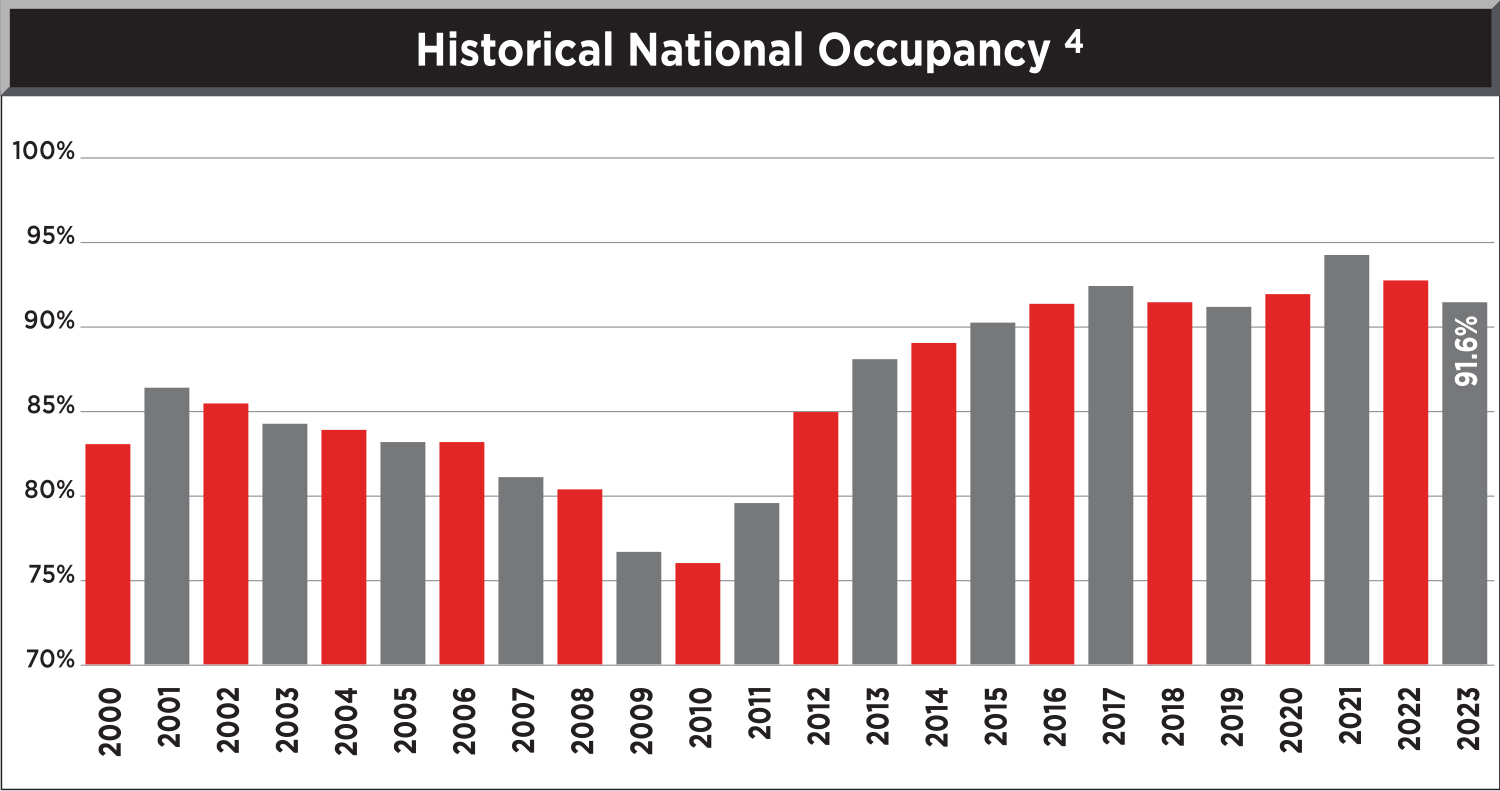

n today’s digital world, it’s imperative that your self-storage website ranks well in online searches. But its position is largely determined by search engine algorithms and optimization.
In the modern era, it’s important to have a basic understanding of digital marketing and website ranking, especially if you operate a business like self-storage. You need to get your brand in front of online customers who would otherwise not know of your existence.
To begin, it’s imperative to understand how search engine algorithms and search engine optimization (SEO) work. Both are constantly evolving in response to societal and technological changes. Let’s discuss the main concepts you need to know as a self-storage operator and some best practices to follow.
Over the years, many companies have found ways to manipulate search engine algorithms, using practices like keyword-stuffing and over-linking. These’ll help a website rank well in the short term, but shady tactics will only hurt your digital progress in the long run. Google will continue to improve its parameters, which become more sophisticated and complex every year, to wipe out sites that use such methods.
As people spend more time conducting business and living life in cyberspace, Google will invest more to enhance its user experience. As a result, we can expect more algorithm updates that make online information easier to find and more accessible than ever.
- Make sure you have a clean, fast website that’s easy to read and accessible. It should be full of industry-relevant information.
- Optimize your website content and tags.
- Earn Google Trust by adding your company and facility information to online business directories and social media pages. Verify that all NAP (name, address, phone) details are correct and consistent across the web.
- Complete and verify your Google Business Profile. It’s also important to stay active by adding pictures over time, responding to all reviews, and answering questions promptly.
- Don’t forget to submit your website to search engines and set up Google Analytics. Track your data and results for ultimate success.
- Scan your website with speed and performance tools, then make adjustments as needed.
The best way to avoid such issues is to keep up with Google algorithm changes. Always follow SEO best practices. Monitor your data, analytics, and keyword rankings.
If you’ve offended Google and find your ranking has dropped, or worse, your website has disappeared altogether, you’ll need to determine the reason. My best recommendation is to hire an SEO expert who can analyze your website. They’ll check your Google Search Console (GSC) to see if there’s been any manual action from a Google auditor. If so, they’ll correct any errors they find and submit the fix to GSC. Once this is done, you should see improvements within a month.
If you’re less fortunate, and were penalized from an algorithm update, your SEO expert will need to look through all the latest updates to see why and correct any errors. Traffic improvements tend to take significantly longer in these cases, with some businesses reporting that it took up to two years to full recovery.
Once you have a solid knowledge base, keep building on it and stay current. As you now know, algorithms are constantly changing. Keeping up with modifications and understanding how they impact your self-storage website rankings will help your business compete for organic results within your local marketplace.
It’s important to note that not all search engine updates are explained or even announced. To help you identify what updates may be impacting your self-storage website, it may be helpful to do some A/B testing. Then, make any necessary corrections based on the results. It may take a couple of months before you see any improvement. If you instead see your rank drop, more testing may be needed, or you may need to reach out to your SEO expert for assistance.
The best advice is to keep up with Google’s best practices. Following them along with the other items mentioned above is vital to your self-storage business’ online success.
elf-storage development has been appealing to many industry investors, owners, and operators over the past few years, following years of minimal development from 2009 until 2016 and solid fundamentals. Development activity sunk as low as 12 million net rentable square feet annually in 2011 and 2012, or around 1 percent of existing supply. As net operating income grew much faster than most other property types during this period, development activity started to pick up in the middle of the last decade and reached a peak in 2018 and 2019 with over 70 million net rentable square feet per year or over 5 percent as a percent of stock. With over 4,598 properties or 415 million net rentable square feet delivered since 2017, this has been one of the most active development cycles in the history of the industry. Despite the new supply, the industry has managed to maintain occupancy levels over 90 percent, a testament to strong demand patterns that for years have outpaced new supply. Looking forward, Yardi Matrix projects supply will remain elevated, yet as a portion of existing supply, annual deliveries will be below the long-term average of 4 percent.
(see National Annual Completions chart)
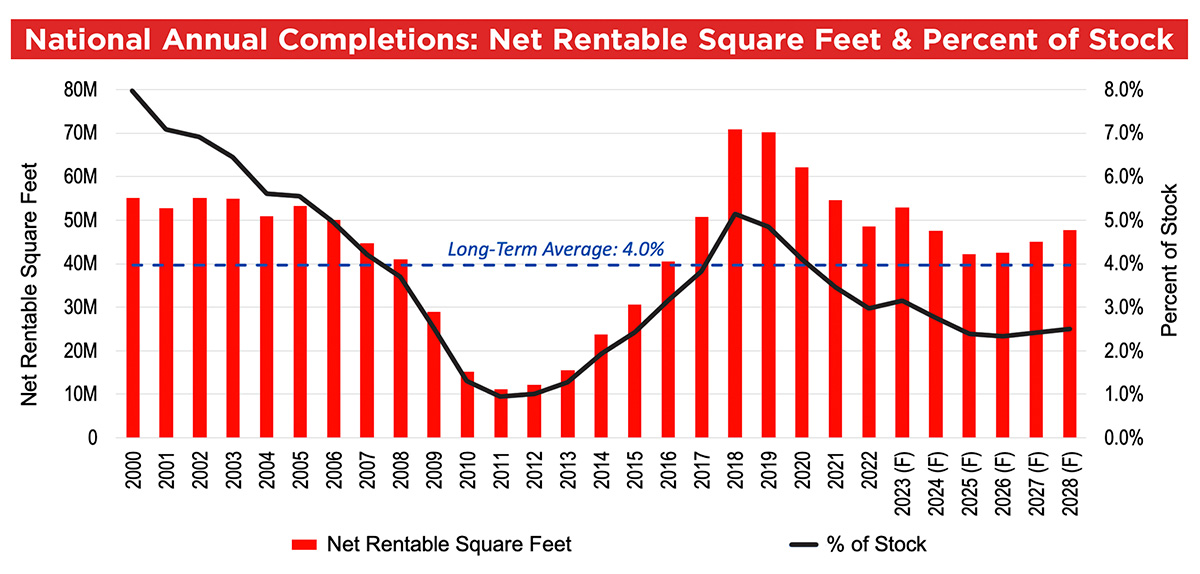
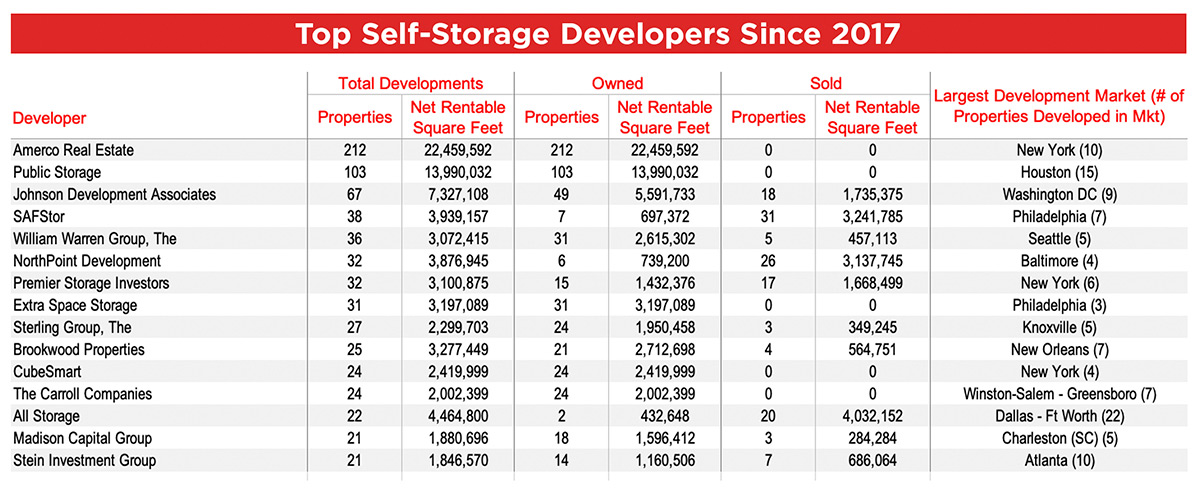
Despite the supply and demand imbalance, strong performance, and plenty of interest in self-storage development over the past several years, it remains a challenging investment strategy to pull off at scale. Laborious land assembly and acquisition, contentious site and zoning review, delayed inspection and final approvals, rising construction costs, and sometimes elongated lease-ups and unpredictable market rents are all barriers to development, and it takes an experienced and savvy company or individual be successful at it. Still, since 2017, self-storage development has been surprisingly fragmented with local and regional players doing most of the heavy lifting. Data from Yardi Matrix shows that since 2017 there has been a total of 2,313 different entities and individuals that have built a self-storage property. The Developers Since 2017 chart shows that approximately 39 percent of all developments have been completed by an individual or company with only one project and slightly approximately 60 percent of developments undertaken by an entity with less than five projects over the past six years. Less than 9 percent of new properties have been completed by a company with 50 or more developments, and only three companies have accomplished this feat (Amerco Real Estate [dba U-Haul], Public Storage, and Johnson Development Associates), while 15 companies have built 20 or more new stores, accounting for 15.5 percent of total stores built this cycle.
(see Developers Since 2017 by Number of Developments chart)
(see Top Buyers of Properties Built Since 2017 chart)


A few of the largest national owners/operators have avoided creating new construction and development divisions to go after development in a significant way and participated in development in limited capacity, for instance, as a joint venture partner with a partial interest or engaging in a pre-sale, including CubeSmart and Extra SpaceOthers, like National Storage Affiliates, have stayed out of development completely. Many of the top developers have been development-focused companies without an acquisitions portfolio, like Johnson Development Associates, SAFStor, and Northpoint Development. Still others are small to mid-sized national operators, like The William Warren Group (dba StorQuest). The Sterling Group (dba Mini Mall) or Madison Capital Group (dba Go Store It), or regional owners/operators like All Storage, The Carrol Companies (dba Bee Safe Storage), or Stein Investment Group (dba Space Shop Self Storage).
Of the 4,598 stores delivered since 2017, over 32 percent of them have since been sold, many of them in large portfolio transactions like the Public Storage/NorthPoint Development portfolio sale in early 2021, in which NorthPoint sold 22 stores to Public Storage, 20 of them developed since 2017. Other stores developed since 2017 were sold as part of larger portfolios, like the $1.5 billion Public Storage/All Storage transaction in December 2021, which included 20 stores developed by All Storage in Dallas/Ft. Worth. A few developers have sold off most or all their stores developed since 2017, either one-off sales or portfolio sales, to recycle the capital on other developments. Sales of newly developed properties have been a significant part of the transactions market the past few years. Of the nearly 5,000 self-storage properties sold since 2020, 26 percent of them have built since 2017. These properties have supported higher pricing in recent years, selling for an average price of $176 per net rentable square foot vs. an average of $137 per square foot for properties built before 2017 (excluding the StorageMart/ Manhattan Mini portfolio).
Top buyers of properties built since 2017 are shown in the Top Buyers table. Most of the top buyers of newly built properties have been REITs, making up 38 percent of sales activity in this cohort of properties since 2017. Some of these acquisitions were conducted through joint ventures with large financial firms, and many were part of portfolio sales. Other large buyers of new developments include NexPoint Group, which acquired Jernigan Capital in 2020, and their portfolio of newly built properties in November 2020. Prime Group has also been one of the most active buyers; it closed on $2.5 billion early in 2023 for their third fund, the largest such fund raised for self-storage investment in history. Other top buyers include large national and regional owners/operators like Strategic Asset Management (dba SmartStop Self Storage), Andover Properties (dba Storage King USA), and Madison Capital, as well as large private equity groups like KKR and Harrison Street Real Estate Capital.
(see Top Buyers of Properties Built Since 2017 table)
Many developers have enlisted larger operators, usually the self-storage REITs, to assist with planning and to lease up the properties for a variety of reasons. Many times, lenders to self-storage developers will request third-party management, and the REITs have responded by rapidly expanding their third-party management platforms. The self-storage REITs have managed nearly 50 percent of all properties delivered since 2017. This has resulted in consolidation of management in the industry, with the REITs expanding their third-party management portfolios by 198 percent, from 767 stores in Q4 2016 to 2,289 stores in Q2 2023. CubeSmart and Extra Space have largely been the operators of choice for many developers and have by far the largest third-party management platforms, managing a total of 1,705 properties for third parties as of Q2 2023. In many cases, this has helped these companies build market intel, sometimes in new markets and submarkets for them. It has also helped companies gain access to deals off-market, acquiring the third-party managed stores from developers during or following their lease-up. New York has been one of the most active markets for development this cycle, and the REITs have been the manager of choice for new stores there.
(see Top Managers of Properties Built Since 2017 table)
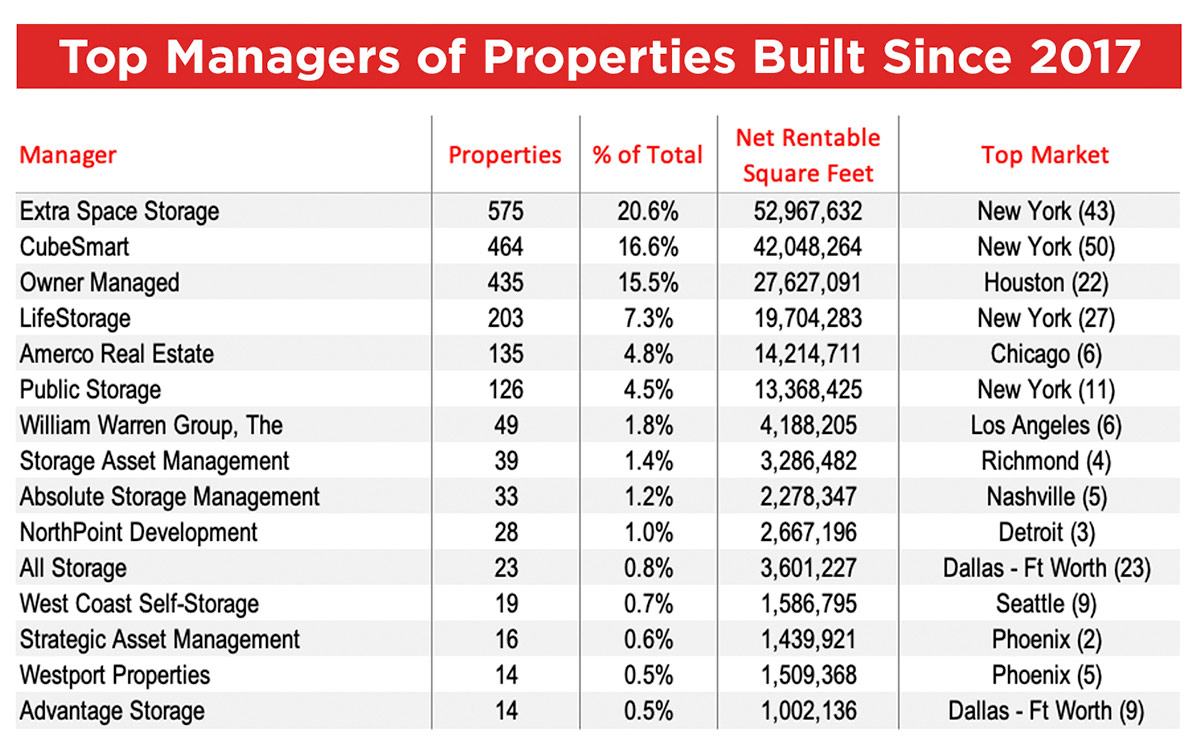

Although construction lending is less fragmented than development activity, there are only three banks that have made more than 50 construction loans for self-storage over the past few years (Truist Bank, Live Oak Bank, and Renasant Bank), accounting for only 6.3 percent of total loan volume. A majority of lending activity has come from companies with between three and 25 separate construction loans, accounting for 53 percent of total volume. For developments currently under construction, the three largest lenders since 2017 are still active, but the lenders with the most loans for properties under construction are SouthState Bank and Bank OZK with 10 construction loans each. The three largest banks in the U.S. (JPMorgan Chase, Bank of America, and Citibank) have made only six total tracked construction loans to self-storage projects over the past few years, accounting for $62.4 million of volume, or just 0.3 percent of total volume. The fourth-largest bank in the country, Wells Fargo, has also been the fourth-largest lender to self-storage developments, with nearly $400 million in volume, and over 91 percent of these loans have closed.
(see Top Construction Lenders Since 2017)
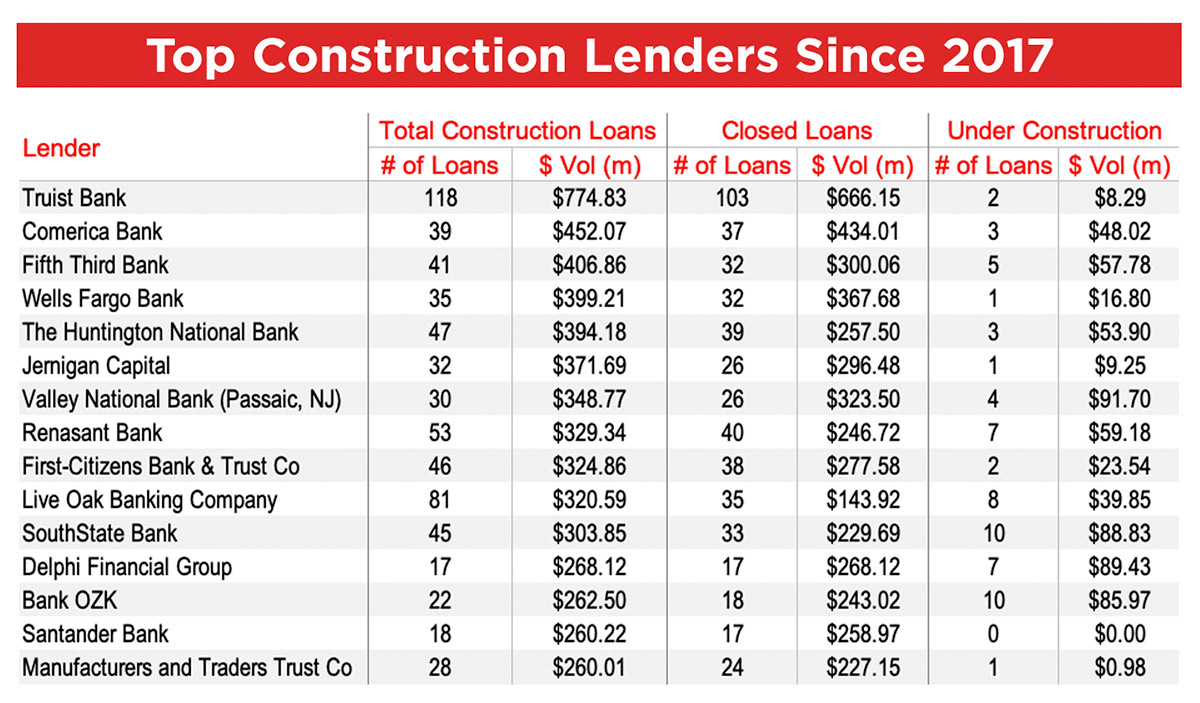
(see Top Developers – Under Construction and Top Developers – Planned tables)
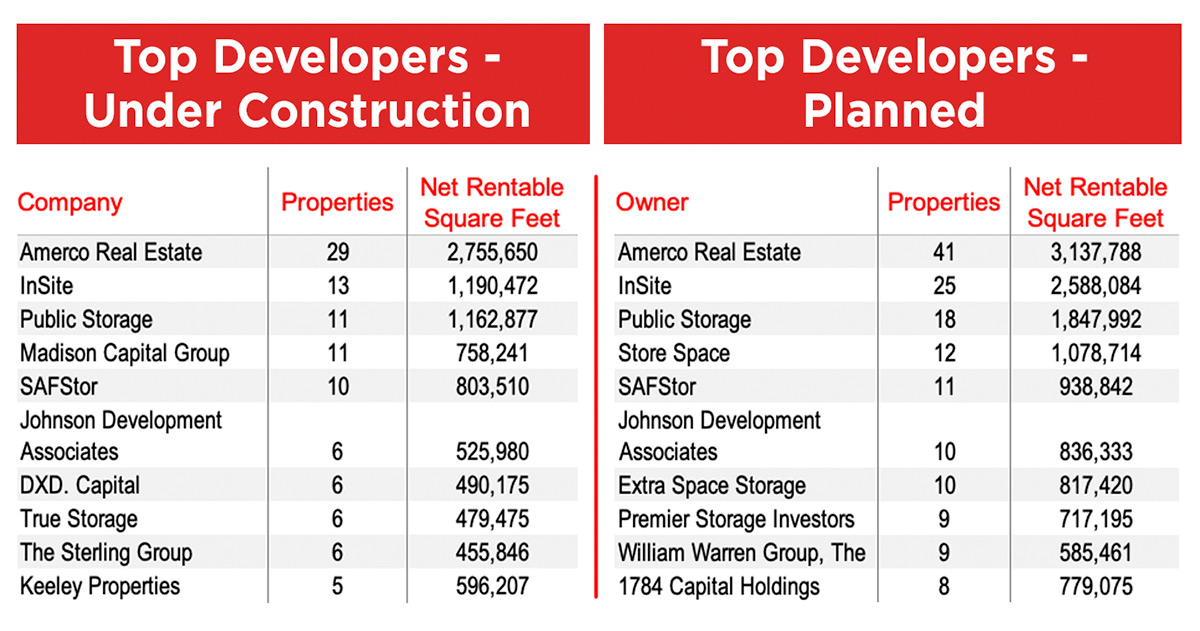
ow do you become one of Australia’s richest citizens? The same way you expand your business from 50 self-storage units to more than 100 self-storage facilities. It takes time and tenacity— two things Sam Kennard, CEO of Kennards Self Storage, which celebrated a milestone anniversary of 50 years in business in 2023, has had on his side for decades.
“The penny dropped. He just loved the idea,” Sam says, adding that he was likely mulling over the specifics of the business on his flight back to Sydney.
The units were advertised with nothing more than a “Kennards Mini Storage” banner and a small advertisement in the Yellow Pages, but they rented rather quickly. With proof that the concept was viable in the area, Neville set to work developing about 100 units on the available land at the property.
Although the self-storage rentals were successful, Neville and his brother Andy continued to focus on growing Kennards Hire. Throughout Sam’s childhood, the self-storage side of the family business grew at a slow pace.
However, in 1981, his father and uncle decided to form a company (Easi Stor Pty Limited) that would specialize in developing, owning, and operating stand-alone self-storage facilities. The newly formed company’s first project, which opened that year, was also the first self-storage facility in Queensland.
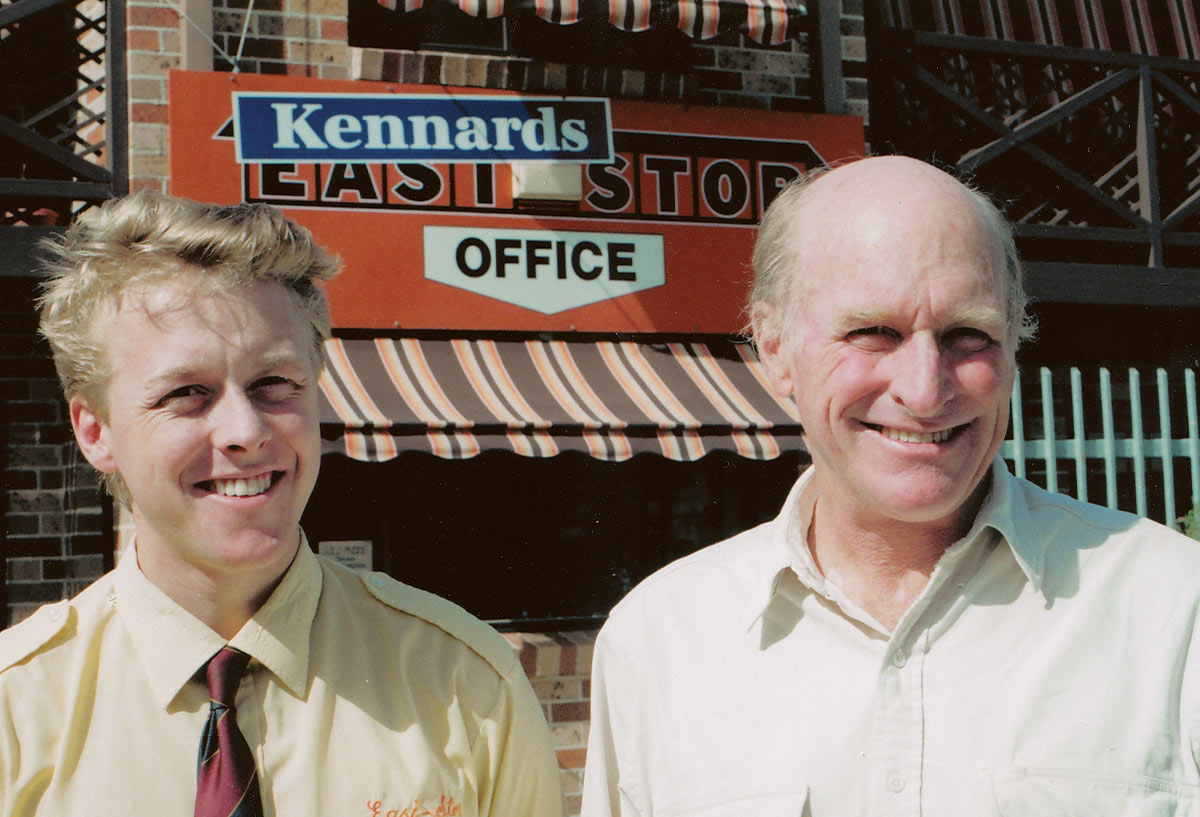
By 1991, Neville was ready to dedicate all his effort to self-storage, so he entrusted Andy with the leadership of Kennards Hire. Sam says the splitting of the business into two separate entities was done “to better enable future generations to own more discreetly without blending cousins, and cousins who get married, and cousins’ cousins. It was a very mature, amicable, friendly negotiation. They used to describe it as trading marbles—‘you have that business, and I’ll have those two properties.’”
At the start of 1991, the business had eight self-storage properties in Sydney, Newcastle, and Brisbane. Neville eventually sold three of his other business ventures (a portable toilet rental business, a construction building rental business, and a generator rental business) to provide capital to grow the storage business.
After attending Hawkesbury Agricultural College, Sam obtained a Bachelor of Business degree in land economics and entered the family business that year at 21 years old. “It was a business degree with a focus on real estate,” he says. “The degree was very useful as it covered property development, feasibility, property finance, property law, marketing, construction, and so on. These are useful skills for the acquisition and development of self-storage properties.”
However, like many new hires, Sam began his self-storage career in customer-facing roles, working in one of the stores as the assistant manager. He was promoted to manager but expressed interest in doing more for the company. Sam was assigned several special projects, such as redesigning the business’ brochure and assisting with the company’s rebranding to Kennards Self Storage, but admits that he, perhaps not so secretly, “always had ambition to lead the family business.”
Around the same time, Neville, now the sole owner of the self-storage business, was preparing the company for the next generation, including Sam and his two brothers, making succession decisions that would eventually place Sam at the helm much sooner than he ever anticipated.
It was December of 1994, three years after Sam joined the company and shortly before his 25th birthday, when Neville abruptly and unexpectedly announced that he was retiring.
Sam recalls his father telling him, “I’m flying to the U.S. after Boxing Day, and I’m going to live there for a year, and you’re going to take over.”
About becoming CEO at a young age, he says, “I was thrown into the deep end.” At first, he wasn’t sure whether he’d sink or swim. Thankfully, though fully immersed in the business and inundated by the learning curve, Sam knew the company’s properties well and could still seek guidance from his father over the telephone (when he wasn’t hitting the slopes in Aspen). Neville also served on the board of directors following his retirement.
“I did not do anything drastic when I took over,” he says. “Just continued with the operating system and development program. My changes were more gradual and incremental over time.”
After a few years in charge, Sam received an email that left him questioning his confidence in the business and himself. “One of my key employees blasted an email through the whole company, just sort of laying out her view,” he says. “She loved the business so much that she thought she’d fall on her sword, telling me everything she thought that was going wrong in the business.”
Sam goes on to say, “I was in denial. I was refusing to accept that this great business had people problems. That was just a blast in the face for me. I did not expect that she would do that. I was very hurt by the fact that she would do something so damaging.”
Compared to the United States, Sam points out that retail is a bigger focus for self-storage facilities in Australia. “It’s a priority to Kennards,” he says, adding that about 6 percent of the company’s revenue is from retail sales. “We market it to people on the street, independently of self-storage.”
The retail areas within their facilities are larger and include a wide range of packing and moving merchandise. “We have an eye-catching distinctively branded range of boxes,” says Sam. “Their visible and unique design assist our retail brand profile. We buy back boxes after they have been used once for sale in our pre-loved range of boxes.”
Another key difference between the U.S. and Australian self-storage industry’s is the demand driver. “Australians don’t move as much as Americans,” says Sam, who notes that they aren’t as mobile due to the affordability of housing. This fact has impacted penetration. With approximately 80 percent of the country’s population living within major metro areas, finding highly visible and easily accessible locations within urban areas has been crucial to Kennards Self Storage’s success.
“We had a people explosion, in the sense, in 1998,” he says. “I reflected, learnt, and made changes to how to lead the team. I changed from an authoritarian style or a command-and-control style to a much more constructive, a collaborative style of leadership, which is much more my nature.”
As Sam worked on elevating the culture, he replaced his entire leadership team, promoting some employees, keeping the fiery employee who sent the email, and adding new positions to create a more efficient work environment. He also makes it a point to give each manager a copy of the book The 7 Habits of Highly Effective People by Stephen R. Covey. Kennards Self Storage has conducted an organizational cultural inventory with Human Synergistics nearly every year since that intense cleanse.
“Our annual culture survey results [known as the Organizational Cultural Inventory] improved the following year,” he says. “The outcome showed people felt a higher level of engagement and ownership, and that their work was valued, and their ideas mattered.”

“Over the years we have accumulated a portfolio of high-quality premium self-storage locations,” Sam says. “It’s no race for me. I’m discerning about getting the best locations.”
Throughout his first decade in the family business, 14 new self-storage facilities were acquired and developed, including its Melbourne expansion with the acquisition of Huntingdale, bringing the total number of facilities owned and operated up to 23.
With the right people in the right positions, and enough cash flow to reinvest profits into the portfolio, the privately owned company was poised for more substantial growth, but Sam recognized that developing self-storage facilities was a slower way to expand the portfolio. “It takes a long time to build a portfolio of storages,” he says. “There are no shortcuts to development. You can’t go out and build 50 locations in three years because the properties are not available, you won’t get the locations, you won’t execute approvals and construction—you just can’t do it.”
For that reason, Sam began seeking acquisitions to propel portfolio growth. After the turn of the century, one of Kennards Self Storage’s largest competitors was up for grabs. Sam was motivated to make a move, but the company would need additional funds before bidding on the 27-property Millers Self Storage portfolio. “At the beginning of the public sale campaign for Millers, we were approached by numerous potential partners,” he says. “Valad Property Group offered sophisticated financial perspective and considerable acquisition experience. The people were also well known to me.”
With Valad Property Group, a REIT listed on the Australian Stock Exchange, as its capital partner, Kennards Self Storage was able to acquire the portfolio for $220 million in 2004 through a 50/50 partnership and nearly double its number of self-storage properties (from 29 to 56) overnight. As for the terms of the acquisition, Kennards retained independent ownership of its existing properties and managed the business for the joint venture. The Millers properties were re-branded to Kennards Self Storage in 2005.
“It was like doing a mini MBA, I think,” Sam says about the acquisition, which required him to work many late nights to get the deal in order. “It’s intense. And it’s stressful. And I did that and decided I didn’t really want to ever do that again.”
The partnership with Valad also enabled Kennards Self Storage to expand into New Zealand with the acquisitions of eight locations in Auckland and other North Island provincial areas within the country.
About four years after the partnership acquired Millers Self Storage, amid the global financial crisis known as the Great Recession, Valad Property Group needed funding, so Kennard Self Storage purchased Valad’s 50 percent share and became the full owner of those joint venture assets. According to the company’s website, “The acquisition involved 38 properties. This was a significant step for Kennards, which remains privately owned.”
Despite that hefty investment to acquire Valad’s share of those properties, Kennards Self Storage continued to experience impressive growth with Sam holding the reins. In less than two decades, his ambition had expanded the company’s portfolio to 69 facilities with a total of 48,631 units and 429,282 square meters (approximately 4.6 million square feet). Still, he set his sights higher, purchasing its Moore Park center for $27 million in 2011.
Pushing past the grief, Sam and Kennards Self Storage celebrated 40 years of operations six months later. The milestone was marked by adding six locations to its portfolio in 2013, including the acquisition of a four-property portfolio in Southeast Queensland for $17 million. By the end of that year, Kennards had a total of 79 facilities with 510,000 square meters (nearly 5.5 million square feet).
Then, in 2015, Sam made the decision to relocate the company’s headquarters to its new flagship location in Macquarie Park in Sydney’s north. Per Kennards Self Storage’s website, “With space to grow, the relocation places KSS alongside many multinational corporate headquarters. It was an opportunity to reset and reposition the company for the future with significant enhancements in systems and technology made in the transition.”
It was an astute move that has enabled Sam and Kennards Self Storage to reach 100 facilities a few months before its 50th year in business. In 2023, Kennards added nine new locations, hitting 109 locations, which generated a net profit of $328 million last year; it currently has 10 additional facilities in the development pipeline. Today, Kennards Self Storage employs more than 300 people and its assets are worth more than $2.2 billion.
Even though Kennards Self Storage is one of the three largest self-storage companies in Australia, the other two being REITs National Storage and Storage King, Sam intends to keep it a private, family-owned business. “I have no plans to list or bring in outside equity partners,” he says, adding that sustainable growth remains his primary objective.
For Sam, the sky is the limit, especially after being ranked one of Australia’s top 50 richest people by Forbes in February 2023. “I still get a thrill from finding and developing locations,” he says. “It still feels entrepreneurial.”
There’s no denying that the designs and amenities of self-storage facilities have dramatically changed over the past five decades. Here are some highlights about Kennards Self Storage’s portfolio from its website:
The 1980s
“Early projects were crude and unrefined, but improvements and innovations were constantly being introduced.”
The 1990s
“The style of development was improved, and individual door alarms were introduced to all developments from 1994.”
The 2000s
“Wine Storage was developed and introduced to numerous locations.” There are now 20 locations with wine cellars, Sam says. He also notes that five or six facilities offer gun storage, a few have safe deposit boxes within vaults, and RV and boat storage is added to locations where space allows.
The 2010s
In general, facilities are larger in size and more multistory facilities are being built, which is “a very different business to the small experimental endeavor started by Neville 40 years earlier in Moorebank.” According to Sam, the average size of a Kennards Self Storage facility is approximately 70,000 square feet.
The 2020s
Customers’ expectations continue to increase; state-of-the-art security features, retail offerings, and contactless rentals are becoming the norm. “The company’s also expanding with plans to undertake mixed-use development including retail, residential, and drive-through restaurants.” Sam notes that mixed-use development enables the company to “buy bigger properties in better locations” and become landlords to vendors such as fast-food restaurants and quick-service retail businesses. Kennards Self Storage has three mixed-use developments opening in stages over the next 12 months.


irst, I must admit that I am biased toward having managers at a storage property. However, as an owner/operator, I totally understand why some developers and storage owners are choosing to operate their storage property remotely to save on the high cost of employees. Most of my storage properties that have been over 700 units have been in metropolitan areas. The large storage properties (one in the San Francisco Bay Area had 2,000 units) that I have developed and/or managed needed managers at the location based on the neighborhood and the sheer size of the property. Remote management of self-storage facilities can offer several benefits, but it also presents some challenges. So, I thought I would give you an optimistic look at remote management and some obstacles that we face when having a remotely operated storage property.
Let’s look at some of the things that make remote storage management attractive to investors and operators.
Flexibility – With remote management, you can oversee multiple facilities from a centralized location, allowing for more flexibility in managing your business. This can be especially useful for owners with multiple locations, especially if they are in fairly close proximity to each other.
Technology Integration – Remote management often involves the use of advanced technology, such as security cameras, access control systems, or Nokē Smart Entry locks, which are amazing but may be too pricey for some operators. A smart watch even allows the customer to open the otherwise secured slider door. This can enhance your remote security and help efficiency when the customer is using your storage product.
Increased Accessibility – With advancement in storage technology, you can access real-time data and monitor your facilities 24/7, enabling you to respond quickly to any issues or emergencies. You may even want to pay to have the property remotely monitored by a security company.
Scalability – Remote management makes it easier to scale your self-storage business as you can expand to new locations without the need for immediate on-site personnel.
Lack of On-Site Presence – Without on-site staff, there may be delays in responding to customer needs, maintenance issues, or emergencies, all of which can potentially affect customer satisfaction. This may be the most critical issue for customers to get problems or issues resolved quickly.
Limited Personal Interaction – Remote management reduces the personal touch and customer interaction that can be important in the self-storage industry. Some customers prefer face-to-face interactions. This is apparent when a customer rents online and then realize that the space in not large enough, too big, is literally upstairs, etc. And many self-storage websites don’t have detailed descriptions to assist the customer with the appropriate space for their needs. Recently, I listened to a live call to a storage property; the customer rented a 10-by-30 online, but when he got to the property, it was inside a hallway. There were nothing noting that on the website, and then the manager said they weren’t allowed to refund money that was paid online. Your company policies should be fair. Otherwise, you may find lots of bad reviews online that give potential customers a poor impression of your facility.
Technical and Staff Challenges – Technology can be unreliable, and if your remote management systems or software fail, it may disrupt your operations and require costly repairs or updates. To cope with the technical challenges, employees or call center agents must have answers and solutions to ensure that the customer has a great experience. Based on my experience with training a call center and listening to recorded sales calls, here are a few common issues that we have come across so far:
“The space I rented online is too big (or too small).”
“The space is too far from the loading area. I would like one closer to the exterior door.”
“There is already a customer lock on the space; I just rented online.”
“My gate code doesn’t work.”
“I need boxes and there is no one in the office.”
“I’m stuck in the gate and can’t get out. I called the fire department; they are going to have to charge you $175 to get me out.”
“There are some people here who are sketchy. Is there anyone here at the property who could come help me?”
With smart locks you eliminate the time it takes for managers to overlock, cut the customer’s lock, or give more or less gate hours. And lock checking is virtual from a portal, so the manager doesn’t have to physically be on the property to check each lock.
In summary, remote management of self-storage facilities offers cost savings, flexibility, and scalability, but it comes with security concerns, potential customer dissatisfaction, and technical challenges. It’s essential to carefully consider the specific needs and demands of your location based on the market needs before opting for remote management, as it may not be suitable for every self-storage facility.
he self-storage industry has exploded in the past two decades. As the industry has grown, the types of self-storage facilities have evolved as well.
Gone are the days when many jurisdictions will allow the single-story metal buildings with roll-up doors that were prevalent through the 1980s and into the end of the century. Developers within the industry, as well as city and town governments, treat self-storage more like retail centers; some even require mixed-use development.
However, there are differences of opinion as to what exactly distinguishes a Class-A facility from a Class-B or a B to a C. Here’s what the experts have to say and why it matters.
Amsdell adds that location doesn’t just mean a highly visible facility on a main thoroughfare. “The market really dictates whether there is a Class-A facility in a particular location,” he says.
Anne Mari DeCoster, president of Kingdom Storage Partners and Self Storage Investing in Scottsdale, Ariz., says the first determining factor for a Class-A facility is whether the property is in one of the top 100 MSAs with the largest urban concentrations. “Rural self-storage properties are not going to be Class A,” says DeCoster.
Class-A facilities in these markets typically are built with higher grade building materials, have at least some climate-controlled units, provide the latest in contactless renting and security options, utilize plenty of cameras, are well lit, and have wide drives. Multistory buildings also include easily accessible loading bays and typically multiple elevators that only allow tenants to access the floor(s) their units are on.
Alex Burman, global director of acquisitions for StorageMart in Columbia, Mo., agrees with DeCoster. Among the determining factors for a Class-A facility in a highly visible urban area for his company is that the location must see a traffic count of at least 15,000 vehicles per day. “It must be on a hard corner or on a major thoroughfare, think where a fast-food location would be, or a Walgreen’s,” says Burnam.
Location is just part of the equation. Age is the second factor, according to many experts. “If you have something that’s more than 20 years old, it likely won’t be a Class-A [facility],” says DeCoster. “Those are likely all drive-up and can’t really be considered Class A.”
While the experts say Class-A facilities don’t have to be multistory, many are. “Most of the modern self-storage facilities are multistory, but they don’t have to be,” says Ann Parham, CEO of Joshua Management, a division of The Parham Group in Bulverde, Texas.
Adam Pogoda, president of Pogoda Companies in Farmington Hills, Mich., says even older drive-up buildings can be Class-A facilities. “I think it has more to do with the amenities,” he says. “There are drive-up properties that have no key locks, plenty of cameras, lots of lighting, and electronic gates.”
For Pogoda, it’s all in how the older properties have been maintained. His company has a multilevel property in Michigan that was built in 1999 that he still considers a Class-A facility. “It’s been maintained really well through the years, getting freshly painted floors, refurbished asphalt, and is kept fresh.”
Pogoda says several other things can make an older property a Class-A facility:
- Landscaping and cleanliness,
- Signage,
- A visible front office,
- Modern and maintained roofs and doors, and
- A modern, up-to-date website that allows customers to do it all from the convenience of their homes.
“You can actually make your Class-B look like a Class-A online with a well-designed website,” says DeCoster.
Class-B facilities likely don’t have the security set up or maybe even lack touchless access with hard lock doors and fewer security cameras. Class-B facilities may be located on gravel, but there’s typically still some sort of wall or fencing with gate access.
“Class-B facilities may also be positioned wonky with regards to access,” says Burnam. “The building may be hidden from a main road and access may be from a side street.”
Pogoda says Class-B facilities are still well-maintained and may have some climate-controlled units. “Class B is really a catch all—everything that’s in between an A and a C,” says Pogoda. “It can be an A or a B-plus with some upgrades.”
They are considered “mom-and-pop shops,” operated by individuals or a couple. “They likely don’t have fences, good lighting, or security,” says Parham. “And sometimes, there’s no manager anywhere around.”
Burnam says they are also typically smaller properties of less than 15,000 square feet and may not even offer paved drive aisles.
- Investors – “I think whether it is a Class-A, -B, or -C [facility] is a spin to investors,” says Pogoda. “It matters to them if your property is for sale or you’re buying.”
- Tenants – Pogoda continues, “I don’t think the average customer cares whether it is an A or a B if the facility is clean, well-managed, and safe. But they will care if it is a C.”
DeCoster believes the most important aspect is whether the facility is well-managed. “If it is an A and is poorly ran, it can be downgraded pretty quickly,” she says.
Burnam adds, “Once inside the unit, it’s three walls and a door. We are basically selling the amenities to make it easier. In the end, that’s what the customer cares about.”
V, boat, and vehicle storage is in high demand these days, and you may be sitting on land that could be converted into additional income. RV sales soared during 2020, and more than 600,000 were shipped wholesale during 2021, making that year one of the biggest in industry history. The need for storage also exploded, as many homeowner associations (HOAs) and cities prohibit them from being parked in residential neighborhoods.
If your research finds there is a need for it in your area and you have one to two excess acres not built out for your storage business, you can convert that acreage to uncovered monthly rentals for relatively low cost.
Jurjevich offers these tips when deciding to convert unused land to RV/boat and vehicle storage:
- Start slow. “Get one or two customers through a small ad in the local newspaper or through word of mouth and see how it works,” Jurjevich advises.
- Invest as little as possible. Until you see what the demand is for this type of storage in your area, keep investment as low as possible.
- Join a trade association for RV/boat storage. Jurjevich says this is important as it will give you access to those in the industry, as well as to attorneys who specialize in this type of lease contract. “The most important step is not to go to a local attorney and have a general real estate contract drawn up,” says Jurjevich. “Go to an attorney who can specializes in leases designed specifically for this use.”
If you find demand is growing for your RV, boat, and vehicle storage, think about expanding and offering more amenities. He says at minimum you will need:
- Gravel or some sort of surfacing if there is grass – “You don’t want to be mowing in between the RVs and vehicles stored there,” says Jurjevich.
- Fencing or a wall – Unless your storage is in a very rural area, Jurjevich says you will likely need at least an 8-foot to 10-foot fence, or ideally a wall.
- Access control gates – This will allow your tenants access during off-hours, while also keeping a record of who is coming and going.
- Sufficient lighting – Many people who store their RVs and boats pick them up before dawn and bring them back after dark. Jurjevich also says, “Tenants want to feel safe, and lighting helps that.”
- Cameras and security – People who park their RVs and boats have a significant investment, and they want to know there is sufficient security to help detour crime. If your facility is in a high-crime area, you may also consider private security drive-bys. At the very least, create a relationship with your local police departments so they can keep an eye on your facility as they patrol.
Of course, the investment for providing uncovered parking is less than covered parking, which you might want to expand to later if your customers are asking for it. As well, rents you will be able to collect are less.
Jurjevich says, “Rental pricing is really a red herring; I’ve had facilities that have a 30 percent price difference within a 45-minute drive.” He adds, as with self-storage, the rent you’re able to charge depends on the demand. “If you’re full, you might be charging too little, and if you’re having trouble filling up, you may be charging too much. You get an idea where to start by talking to competitors and then doing the best you can until you hit the spot.”
Other advantages to using a small plot of land for uncovered parking include:
- Turning land that isn’t generating income into a profit-generating part of your business.
- If you eventually intend on building another phase to your self-storage, intend on using the property for something else later or selling it, you can easily convert the land back for that use.
- Customers who are seeking outdoor uncovered storage are generally “a little more self-sufficient,” says Jurjevich. “They don’t ask you for much or require much attention.”
- Delinquencies are generally low. Jurjevich says in a decade of being in the business, he has had to do less than one dozen auctions.
- The items are collateralized. Even if you go to auction, Jurjevich says you’re sure to collect your bad debt.
If you aren’t on site, you might want to hire a professional management company. However, if that isn’t possible, you will need to monitor what is being parked on the property and make sure tenants are caring for their vehicles and boats.
“If you let something go, before you know it, you will have a bunch of unkept vehicles and boats on the property, which will attract more people who don’t keep their property in working order, and you don’t want those types of renters,” says Jurjevich.
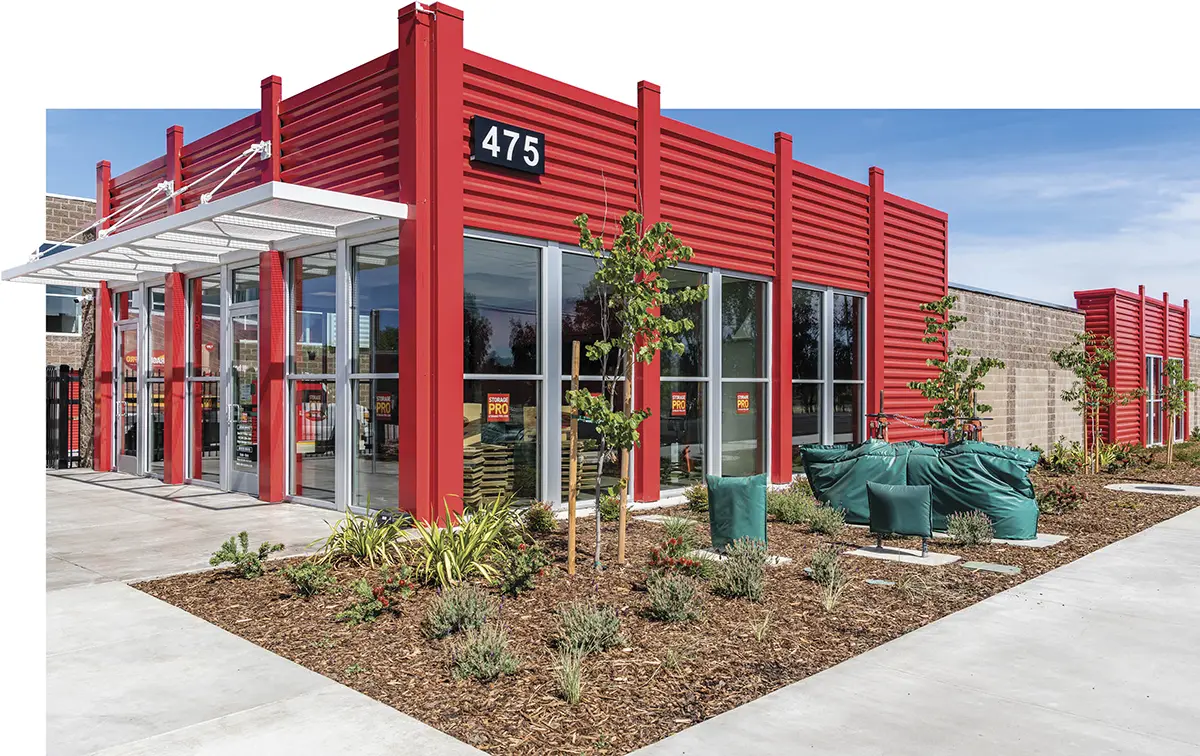
otwithstanding supply chain issues, significant increases in material costs, and lengthy delays because of the COVID-19 pandemic that extended development by 12 months, as well as the mid-project passing of the architect, StoragePRO at Fairfield, a sleek, 108,743-rentable-square-foot facility in Fairfield, Calif. (a bedroom community of the San Francisco Bay Area), opened in October of 2022, two years after breaking ground.
StoragePRO at Fairfield includes five single-story buildings, a two-story building, and a 1,100-square-foot office. Storefront glazing on three sides for an expansive view of the retail-oriented office and enclosed, illuminated “faux” units along the store’s frontage create an attractive façade. It is 100 percent solar powered and utilizes LED lighting. For convenience and security, the facility is equipped with PTI’s DoorBoss and Gate Entry System and offers eight covered stall parking spots for customer elevator access to the second floor.
Managed by StoragePRO Management, Inc., and located at the highly traveled I-680/80 intersection, StoragePRO at Fairfield’s visibility, vibrant color scheme, and outstanding offerings have already attracted an ample number of tenants, renting 74 percent of its 936 units in less than 14 months.

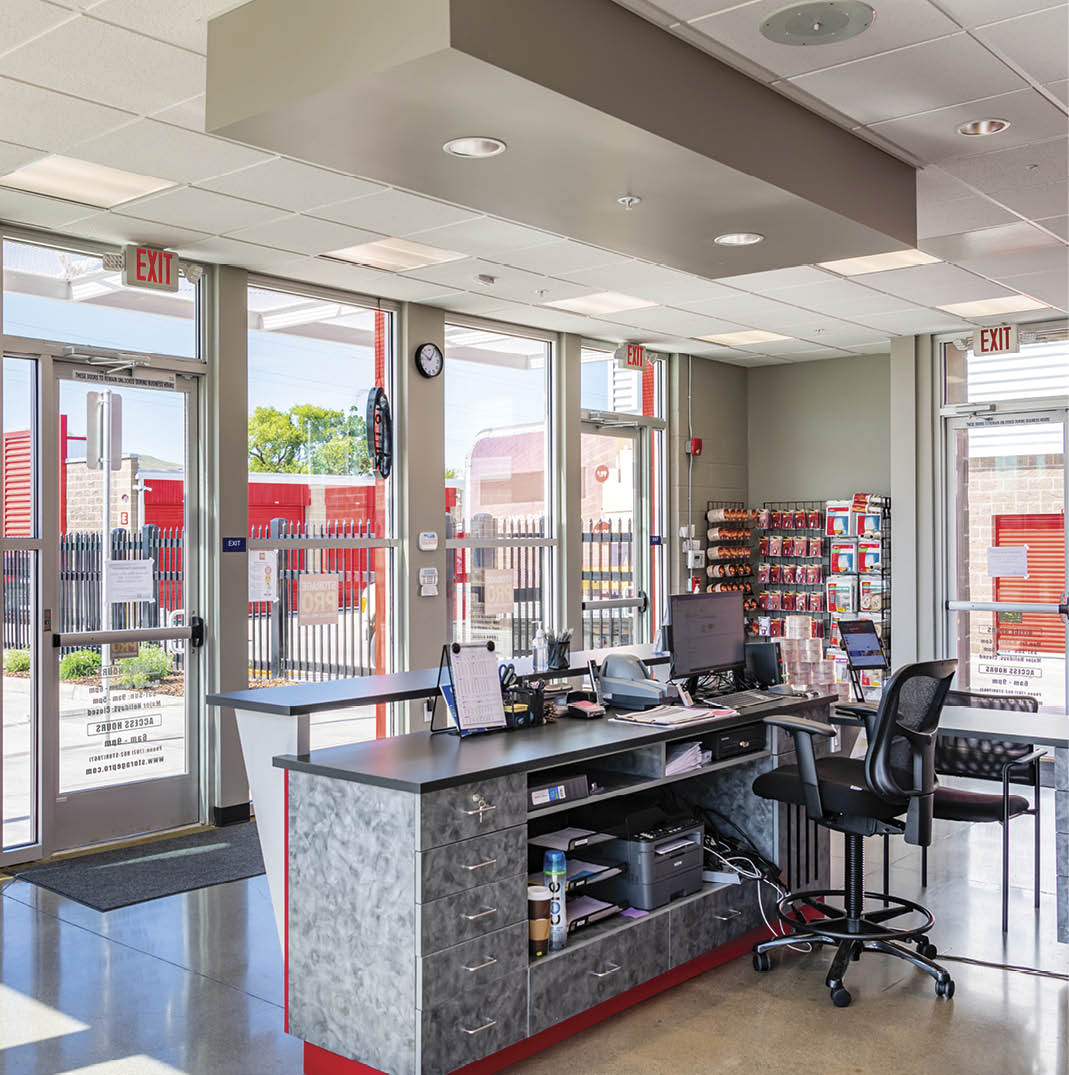
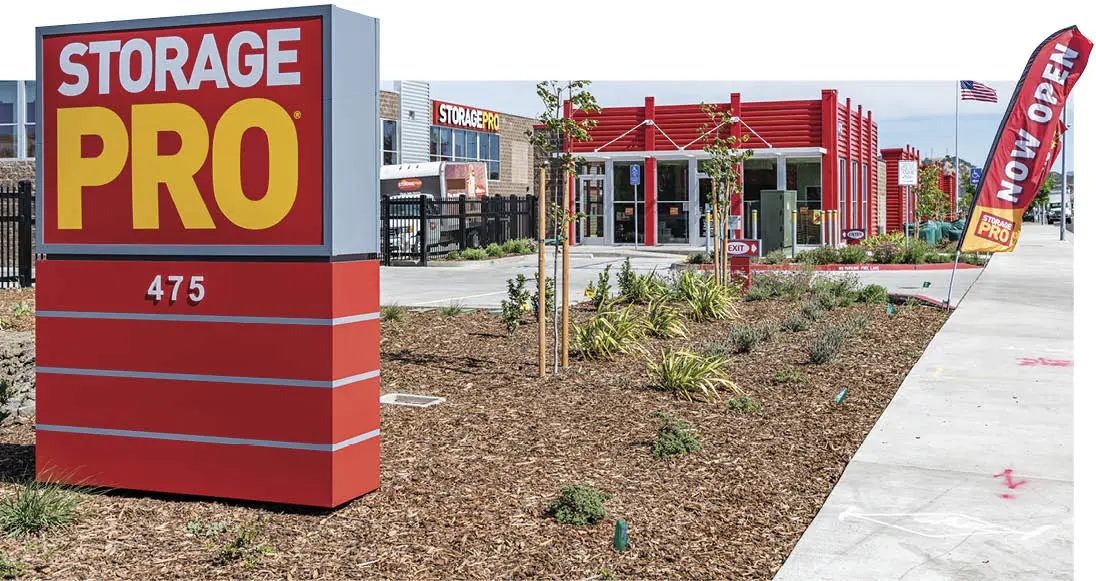
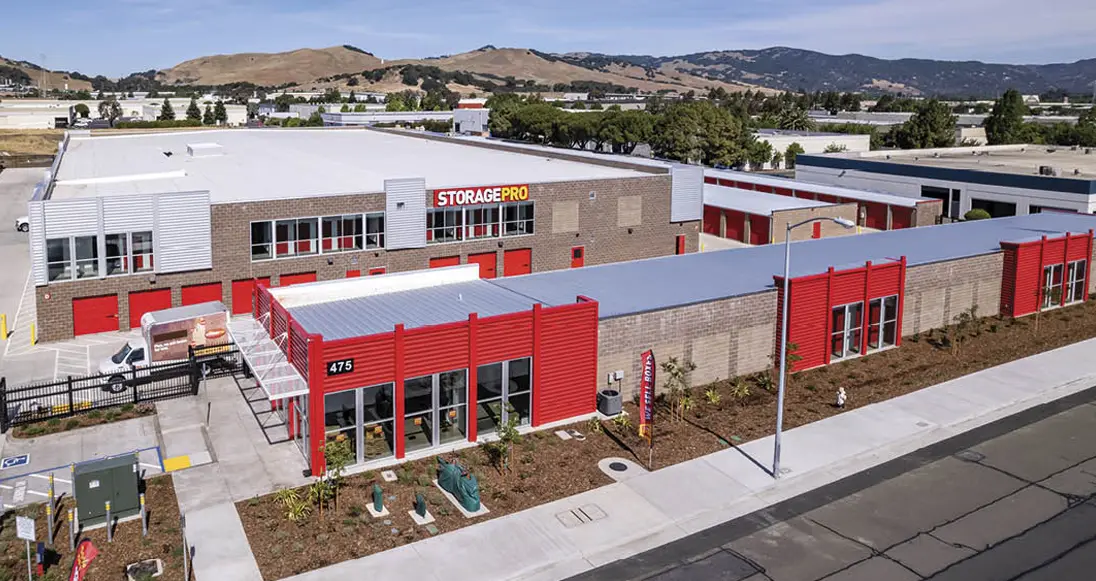
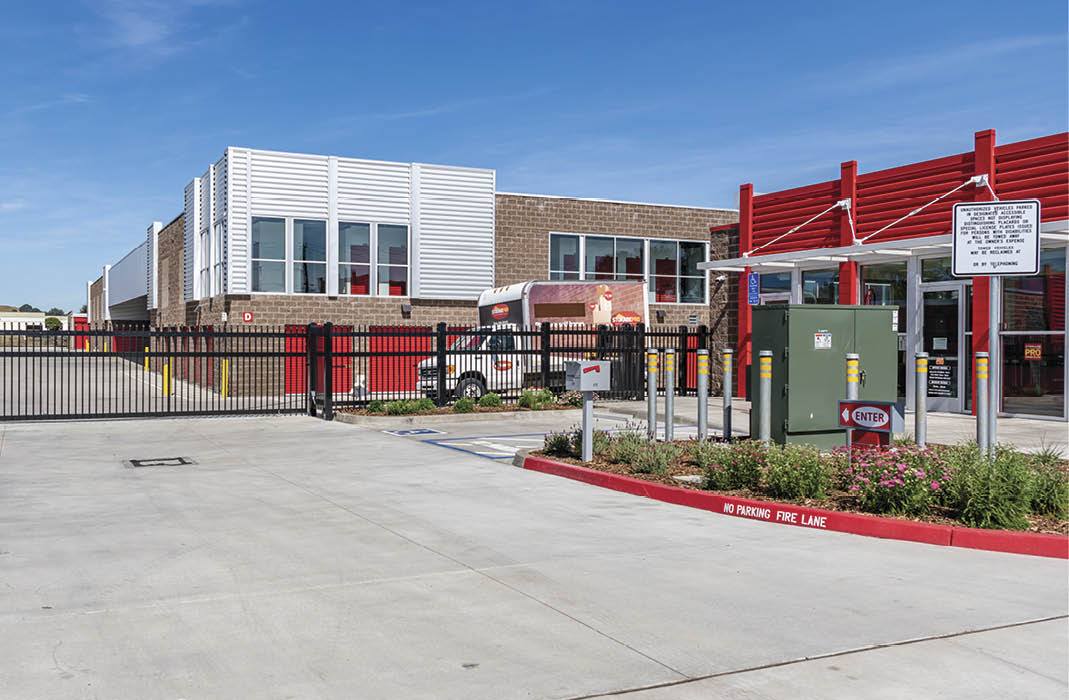
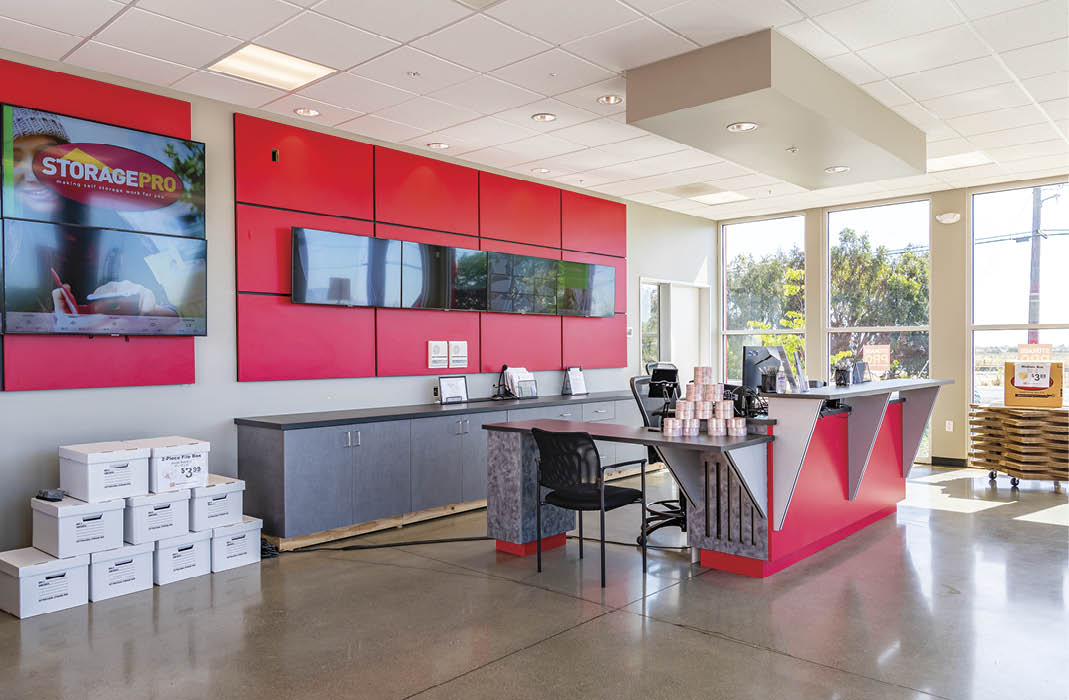
enewable energy sources including solar are producing an increasing percentage of electricity generation in the United States. Solar energy generated 3.4 percent of the total utility-scale electricity production in the United States in 2022, according to the U.S. Energy Information Administration (eia.gov/energyexplained/electricity/electricity-in-the-us.ph). All renewable sources combined produced about 22 percent of the total electricity generation. This compares with about 12 percent in 1990.
Fossil fuels generated the largest percentage of U.S. electricity in 2022, with natural gas at roughly 40 percent, coal at nearly 20 percent, and petroleum at less than 1 percent. Nuclear energy produced nearly 20 percent.
Some major self-storage companies have been making significant investments in solar power.
For example, Public Storage and commercial and industrial rooftop solar developer Solar Landscape said in a news release Aug. 1 that they would add solar infrastructure to 133 of Public Storage facilities’ rooftops in Maryland, New Jersey, and Illinois “to provide historically overlooked communities with affordable renewable energy.”
Public Storage, based in Glendale, Calif., and Solar Landscape, based in Asbury Park, N.J., said the “community solar installations” would provide renewable energy to more than 10,000 homes to residents with low or moderate incomes and save subscribers millions of dollars a year on electricity costs. Public Storage has committed to install solar on more than 1,000 of its self-storage facilities by 2025.
“Community solar furthers Public Storage’s strong commitments to sustainability and our communities,” John Sambuco, Public Storage’s president of asset management, said in the release. “We are providing affordable renewable energy for low- and moderate-income residents, reducing our collective carbon impact on the environment, and converting non-used rooftop area into socioeconomically productive space for our company.”
Another big industry player, Extra Space Storage, based in the Salt Lake City area, said in a July 17 press release that in the past five years it had completed solar installations at more than 400 of its facilities. These solar installations have saved enough energy to power more than 10,000 homes for a year. The company also plans to install hundreds of additional solar systems on its facilities.
Extra Space says the Global Real Estate Sustainability Benchmark ranks it as the top U.S. self-storage company for sustainability.
McKall Morris, Extra Space’s communications and sustainability manager, said in an interview that 11 percent of Extra Space’s energy consumption in its wholly owned, joint venture, or managed properties is offset by solar-generated electricity. The company says in its 2022 sustainability report that it aims to double that percentage by 2025.
At the end of 2022, the company was using solar power at 55 percent of its 1,133 wholly owned facilities, Morris says. Extra Space uses most of its solar-generated electricity to power its facilities. It also sells a small percentage of the electricity to area utility companies and leases its roof space for some community solar projects.
“A lot of the sustainability efforts we have done to date have been easy decisions for us because they are at the intersection of what’s good for the environment, what’s good for the community, and what’s good for our shareholders,” Extra Space CEO Joe Margolis said in the release. “Solar has been a great thing to reduce our electricity use while producing a great return for our shareholders.”
Baja Carports, based in Martinez, Calif., has installed solar support systems, solar-ready carports, standard carports, and covered RV canopies for 38 years, according to its website (bajacarports.com). Baja was one of the first companies in the United States to use solar panels as actual carport rooftops. The company describes its trademarked brand of solar support systems as being recognized nationally in the solar industry as a leading solar racking mounting system.
“We see the future of Baja Carports solar support systems (solar carports and solar-ready carports) as no longer being an amenity or, for that matter, an afterthought for down the road installments, but a standard in building and property development,” according to Baja’s website. “The Baja carport team is inspired by what we see, read, and hear each day about the solar industry. Our customers are harnessing renewable energy. They fully understand what Baja’s solar support systems can do. … Each is self-sufficient and in control of their electricity production. Knowing Baja Carports is a part of our customers’ carbon footprint success is the reason why we continue to design and engineer new innovative pre-engineered framing support systems.”
Baja Carports CEO Robert Hayworth says the majority of solar systems used in self-storage are part of new construction, though some facility owners install them on existing facilities, whether to sell the power to utilities, use it to power the facilities themselves, or both, which Baja does. Solar systems on rooftops add about 3 pounds to 5 pounds of deadweight per square foot, which most self-storage buildings and RV and boat storage structures can’t support without further strengthening.
“I’ve seen a lot of guys just put it up anyway,” Hayworth says. “It voids the warranty because it could damage the building. Any city with half a brain won’t give a building permit.”
Companies that install solar power systems can get tax credits for as much as 60 percent of their costs through the Inflation Reduction Act of 2022 and other tax credits, Hayworth says. RV and boat storage qualifies for the credits because RV canopies are considered solar support systems. On self-storage, tax credits apply to the cost of the solar systems themselves but not the buildings.
Installation of solar systems on existing structures require penetration of the roof, “so you have to be real careful on mini-storage,” Hayworth says.
“Leaks could damage contents,” he says. “You can’t have a leak with storage. But if you put it on RV canopies, nobody cares. It’s better on RV canopies or carports instead of mini-storage. [The Los Angeles Department of Water and Power] will pay you 14 cents a watt for power. If you have an existing rooftop that’ll take the weight in LA, then you can make quite a bit of money on it.”
Solar systems for new construction vary from $1.15 to $2 per generated watt depending on the region, Hayworth says. This would probably equate to $30 a square foot of roof area on RV canopies and on self-storage facilities. Solar systems can save more money on energy costs for climate-controlled facilities.
Regarding costs to incorporate a solar system in a storage facility, he uses as an example a 15-acre RV and boat storage facility with canopies on it. It probably would use a 40-kilowatt system, which costs between $80,000 to $100,000. Depending on the state, the system can offset energy costs by possibly $1,500 a month. Tax credits can reduce costs by 40 percent to 50 percent.
Maintenance of solar systems is minimal, Hayworth says. It involves replacing the inverters every 10 years (inverters convert DC current to AC current) and washing the system at least once a year.
ESA, a solar energy systems provider based in Maitland, Fla., says on its website (esa-solar.com/sharing-the-sun-exploring-self-storage-community-solar-initiatives) that self-storage businesses have evolved in recent years beyond their core function of providing convenient storage space for personal belongings. Because some self-storage companies are expanding their facilities into community solar providers, they are helping the environment and businesses that don’t have room to install solar systems on their sites.
“By harnessing solar energy, these businesses not only offset their own costs but also generate revenue for themselves,” ESA says. “This approach facilitates a sustainable future while promoting economic growth. These solar projects show that businesses are changing how they view their impact on the environment and their communities. They’re not just storage places anymore; they’re examples of clean energy, lighting the way to a greener future.”
By installing big solar systems, self-storage owners “are transforming themselves into powerhouses of clean energy production, effectively becoming energy providers for their communities,” ESA says. “This transformation isn’t limited to the self-storage industry alone; it sets an inspiring precedent for businesses across various sectors. By investing in renewable energy infrastructure, a single business can act as a catalyst for a wider shift towards sustainability.”
ESA describes the integration of self-storage businesses with community farms, which it calls “a brilliant solution that can transform how we think about energy production and distribution.” ESA breaks down how it works as follows:
- Energy generation
- Energy distribution
- Shared benefits
- Environmental benefits
- Advantages of self-storage and community solar:
- Sustainability
- Community engagement
- Energy resilience
- Environmental stewardship
- Collaborative system
- Financial incentives
- Offsetting costs
“The integration of community solar within self-storage businesses marks a shift in sustainable practices and a revolution of democratized energy generation,” says ESA. “By sharing the generated energy among multiple businesses and individuals, these enterprises contribute to the local economy while reducing their carbon footprint. Through collaboration and a commitment to sustainability, self-storage businesses are redefining their roles in society and becoming key players in the transition toward a greener future. As the potential for renewable energy continues to expand, the utilization of community farms represents a win-win solution for both environmental stewardship and financial success.”
Solar investors generally are benefitting from solar power’s decreasing cost and increasing efficiency, according to the Environment America Research & Policy Center (EARPC) in its report on solar on warehouses (environmentamerica.org/center/resources/solar-on-warehouses).
The organization calls solar power the fastest-growing sector of energy production in the United States. It says the U.S. has the capacity to produce nearly 80 times as much electricity using solar photovoltaic energy as it used in 2020.
American warehouses’ rooftops built before 2019 can generate 185.6 terawatt-hours (TWh) of solar electricity a year, enough to power more than 19 million average homes, the EARPC said. California, Florida, Illinois, Texas, and Georgia have the most potential for warehouse solar power generation.
The EARPC calculated its estimate of warehouse solar generation potential by state and region compared to other energy sources using the U.S. Energy Information Administration’s 2018 Commercial Building Energy Consumption Survey data.
Jerry LaMartina is a freelance reporter and editor based in Shawnee, Kansas.

ike airline travelers bracing for expected turbulence, business owners are preparing for a tricky operating environment in 2024. On the upside, the economy will continue to grow, although at a slower pace. Consumers and businesses are both feeling fairly optimistic, unemployment remains low, capital investments are plugging along at a healthy pace, and the all-important housing market is burgeoning.
Throwing cold water on the good times, though, is a significant downer that no one can control: Higher interest rates established by the Federal Reserve to control inflation are putting a damper on business activity. Economists are taking note by lowering expectations for the next 12 months.
“We expect real GDP to grow 1.4 percent in 2024,” said Bernard Yaros, Jr., assistant director and economist at Moody’s Analytics. That’s slower than the 2.1 percent increase expected when 2023 numbers are finally tallied, and below the 2.0 percent to 3.0 percent considered emblematic of normal business growth. (GDP [gross domestic product], the total value of the nation’s goods and services, is the most commonly accepted measurement of economic growth. “Real” GDP adjusts for inflation.)
Slowing commercial activity will affect the bottom line. Moody’s Analytics expects a decline of 4.5 percent in corporate profits for 2023 and forecasts only a modest recovery of 0.3 percent in 2024.
Reports from the field confirm the economists’ readings. “Our members are experiencing a business slowdown, due largely to the effect of increasing interest rates,” said Tom Palisin, executive director of The Manufacturers’ Association, a York, Pa.-based regional employers’ group with more than 370 member companies. While businesses understand the need for higher interest rates, they nevertheless hope for early relief. “If inflation does not continue to drop, interest rates will have to be increased further, which will be a big problem,” said Palisin.
So, are the Federal Reserve’s efforts paying off? There’s some good news here, as well as a sunny forecast. Moody’s Analytics expects year-over-year consumer price inflation to average 3.2 percent when 2023 numbers are finally tallied, down from over 6 percent a year earlier. Moreover, the number should continue to drop until it reaches the Fed’s target rate of 2 percent late in 2024. (These figures represent the “core personal consumption expenditure deflator (PCED),” which strips out food and energy prices and is the Federal Reserve’s preferred measure of inflation.)
Indeed, Moody’s Analytics believes the Fed will start to lower interest rates around June of 2024, although more slowly than previously anticipated because of persistent inflation and ongoing labor market tightness. Cuts of about 25 basis points per quarter are expected over the next few years until the Federal Funds Rate reaches 2.75 percent by the fourth quarter of 2026 and 2.5 percent in 2027.
The public mood is a strong driver of the economy. And here the news is good. “Consumer confidence has been trending higher, and I think prospects are good for it to improve next year,” said Scott Hoyt, senior director of consumer economics for Moody’s Analytics. “Things should normalize as the economy continues to grow and gas prices stabilize.”
One major driver of consumer confidence is a healthy job market. “The unemployment rate has been very low, bouncing around between 3.5 percent and 3.8 percent for some time,” said Hoyt. A slowdown in job growth orchestrated by the Federal Reserve’s interest rate hikes should moderate things. “We think unemployment will trend upward a bit, ending 2023 around 3.9 percent and 2024 around 4.2 percent.” (Many economists peg an unemployment rate of 3.5 percent to 4.5 percent as the “sweet spot” that balances the risks of wage escalation and economic recession.)
Low unemployment may fuel happy sentiments among citizens, but it presents employers with two practical challenges. The first is the need to raise wages to attract sufficient workers. “Wage and salary income growth has been strong, fueled by a tight labor market,” said Hoyt. “We’re expecting it to increase just a shade over 5 percent both for 2023 and 2024.” In 2022 the growth was a little over 8 percent.
Reinforcing the estimates of the economists, Palisin said his members have had to hike their compensation to remain competitive among themselves and other economic sectors. The group’s entry-level hourly wages increased an eye-popping 8 percent to 10 percent in both 2022 and 2023, far higher than the historic average of 2.5 percent to 3.0 percent.
Problem No. 2 is a scarcity of workers. Inability to hire enough people, particularly of the skilled variety, can affect the bottom line. Two problems contributing to a labor shortage are the retirement of baby boomers and a post-pandemic reordering many people are making of their life goals. “Demographic structural changes in the U.S. mean we just don’t have, in many cases, the number of workers needed in manufacturing to meet demand,” said Palisin. “That’s not going to change.”
The situation has become a bit nuanced as the recent economic deceleration resulted in a hiring slowdown. “The labor market is still tight, but it’s not as bad as it was a couple of years ago,” said Bill Conerly, principal of his own consulting firm in Lake Oswego, Ore. “While we still have more job openings than unemployed people, the margin is not as large, and we don’t have all the quiet quitting that we had before.”
While employers never like having to raise wages, putting a cap on paychecks has taken a backseat to a more urgent concern: keeping valuable talent from jumping ship. “The big question now is not so much who can pay the most for entry-level and skilled jobs, but what can they do to retain these folks within their companies,” said Palisin. “Manufacturing in the U.S. over the last year has continued to hire pretty significantly, and we’re not seeing a lot of layoffs, so that tells you that companies are hoarding talent.” Employers are fine tooling their operations in the areas of workplace flexibility, benefits, and culture changes.
Given the generally upbeat consumer sentiment, prospects are good for the housing sector, an important driver of the overall economy. “New home sales are running at the top end of the range set in the decade preceding the pandemic,” said Yaros. “One reason is that a lack of existing inventory is pushing buyers to consider new homes. The construction industry is stepping in to close the gap, and housing starts have exceeded expectations.”
The construction of new homes is being fueled by a cold, hard fact: There aren’t enough existing homes to meet demand. “The 3.1 months’ supply of existing homes remains well below the four to six months of inventory that is considered a balanced housing market,” noted Yaros. Strong demand caused a 10.3 percent increase in the median price for existing homes in 2022, and a 0.6 percent increase in 2023. A correction of 1.1 percent is expected in 2024.
For an explanation of the scarcity, look no further than the run-up in mortgage rates. The ultra-low interest rates of existing mortgages amount to a strong financial incentive for existing homeowners to stay put. “Current homeowners had refinanced their investments at 3 percent or 4 percent,” noted Conerly. “Replacing what they had with better homes would require walking away from those mortgages to take on new ones at 7 percent. I think we’ll see this trend continue for another year, but I think we’ll also see a lot of strength in remodeling, and that will be financed probably with home equity lending or second mortgages.”
High interest rates, an inflationary environment, and rising worker wages are a trilogy of challenges that in normal times would dampen business confidence. And there are other threats to corporate wellbeing, such as high energy costs resulting from the Russia-Ukraine war and an appreciation in the U.S. dollar that hampers export activity.
Despite all this, companies don’t seem to be planning any dramatic adjustments to their operations, in marked contrast to their cautious attitude of a year earlier. “While our members have moderated their expectations for the future, they are still feeling slightly positive,” said Palisin. “One reason is that we seem to have avoided the recession that many were predicting.” Moody’s Analytics believes that the nation will avoid a recession in 2024, attributing its forecast of a soft landing to resilience in labor markets and consumer confidence.
Another driver of optimism is a recent brightening of the supply chain picture. “There has definitely been a shift in the awareness of the risks of doing business in China,” said Palisin. “This has resulted in a reorganizing of supply chains into nations such as Vietnam, Philippines, India, Mexico, and the U.S. The jury is still out as to what nations will benefit most.”
“The 3.1 months’ supply of existing homes remains well below the four to six months of inventory that is considered a balanced housing market.”
Indeed, many businesses are taking action on their good feelings. “The commercial sector looks very strong to me,” said Conerly. “Given the current level of interest rates, I’ve been surprised to see the healthy level of capital spending.” Conerly said that manufacturing facilities seem to be the biggest gainers in non-residential construction, with new semiconductor facilities especially benefitting from the CHIPS Act. Suburban office construction has been doing surprisingly well, despite vacancy rates in urban centers. So have suburban neighborhood strip centers, which had been neglected for too long because of fears that Amazon would capture all the retail business.
Conerly identifies three forces propping up equipment purchases. The first is the CHIPS Act and the construction of semiconductor facilities. The second is the automation being installed by companies nervous about being able to hire people. And the third is the trend toward reshoring by companies that are trying to shorten their supply chains.
Businesses looking to borrow funds to fuel capital investments, though, had best prepare for a tougher negotiating environment. “The banking sector is in retrenchment and lenders are becoming more risk averse,” said Anirban Basu, chairman and CEO of Sage Policy Group. “As a result, developers are having more difficulty lining up financing.” Fueling the concern among financial institutions is a recent spate of loan delinquencies and bankruptcies. Banks are looking at their portfolios and seeing where they can tighten up. Companies holding inexpensive pre-pandemic loans will see an earnings hit when they need to refinance at 6 or 7 percent.
In the opening months of 2024, economists are advising businesses to keep an eye on some key statistics to get an idea of how the year will turn out. Among them:
- Inflation – “If progress in core disinflation stalls out, that would likely mean the Fed will keep interest rates at their current level for longer than we are currently assuming,” said Yaros.
- Employment – “Total employment in the country is a good measure of current conditions,” said Conerly. “And any increase in initial claims for unemployment insurance could foreshadow a slowdown.”
- The Yield Curve – “A reversion in which short-term interest rates exceed long-term ones could foreshadow a coming economic slowdown,” said Conerly.
Whatever the condition of the tea leaves, businesses in general will encounter a tougher operating environment in 2024, characterized by a need to finesse a tight labor market and reluctant lenders. “In the coming year we will face uncertainty about inflation and interest rates, shortages of labor, higher energy costs, a slowdown in China’s economy, and recurring threats of a federal government shutdown,” said Palisin. “There are a lot of spinning plates in the air, and some of them may fall and crack.”
New York-based freelancer Phillip M. Perry negotiates win-win deals with his clients everywhere.
he REITs have always taken the lead in how to manage self-storage rental rates for maximum profits. This included online rates vs. office rates, sign-up rates, discounts, and rate raises. Given their size and massive data collection, they can quickly determine what works the best for them. And once again they have a new pricing strategy that may work or turn out to be a grenade. In the long run, having REITs as your competition was good because they regularly raised rents and street rates, whereas many mom-and-pop operators did not even raise rates when they were full.
Typically, the REITs had teaser discounted sign-up rates. Then in three to five months, they would raise the rates. And then a second rent raise in seven to nine months. After the first year of two rent raises they might reduce it to a rent raise every nine months. A $29 rent raise was often the maximum rent raise. At this price point, they found most tenants did not move out.
The REITs often offered a free month with their teaser rate. In the past, when they were full, they would eliminate the free month’s rent or reduce it to a half month. The REITs would also raise existing tenants above the street rates they charge new customers. So, a long-term renter could be paying $200 plus more than the current move-in for a 10-by-20 unit.
I can tell you firsthand that renters were frustrated when they received a second $29 rent raise in less than a year. A Storage Authority Franchise owner opened a facility in Houston, Texas, about four years ago. They were surprised in the first month open that they got a dozen clients who moved over from the nearby REITs because they felt deceived by high rent raises, and they were frustrated enough to move.
Late fees and administration fees were often $20. Now we are seeing them up to $37 plus tax.
Many of the REITs have a new pricing strategy. It’s based more on short-term occupancy, and I assume they hope for long-term profits. They are substantially reducing moving rates and then substantially increasing rates in three months without warning. They are often raising the rental rates a whopping 50 percent.
I just got a call from one of my managers who had a renter move to our facility from a REIT facility because they just got a $90 per month rent raise.
I just read a national ad for one of the four REITs: One month free and 40 percent off. No one can survive financially with these rates, unless, of course, rents are raised significantly just after the free month.
Make no mistake, this is a problem for existing owners who are not willing to follow in the REITs’ footsteps. It is also a problem for existing developers.
If you’re an independent, you need to know your competition strategy so you can beat them at their own game. Call your competition, and once you get a rate, ask how long it is good for. Most of the time the answer is “I do not know” or two months. It might be worth renting a 10-by-10 unit and experience their rental rate increases firsthand so you can share with your prospects what will happen down the street.
The good news is 60 percent of renters rent at the first place they visit. So, you must have a superior sales and marketing plan that is implemented to compete with the REITs. The REITs use call centers that use the perfect script, while mom-and-pop managers are still winging it. It’s time to change your business model from a real estate-based self-storage operation to a hospitality-based operation.
This new strategy is tough for self-storage developers when they are going for a loan. The average bank/lender sees the REIT move-in rates. So, when you have higher rental rates in your projections, they ask if you are sure you can get these rates. Developers need to make sure the company that does their feasibility study understands the new REIT move-in rental rates strategy, so they do not use the temporarily discounted competition move-in rates as your rates for your new facility. In many cases, the numbers will not work with the REITs’ new move-in rates.
It will be interesting to see how this new pricing strategy plays out. So far it is working for the REITs. Published rental move-in rates are down year over year, but their profits are up.
We have come so far over the last 20 years, let’s hope the need for profits by some does not give us all a black eye. Imagine if you rented an apartment and they raised your rate in three months and again in nine months. Already renters have been complaining to their state legislation about unfair practices. A couple of state legislators have discussed limiting self-storage rental rate increases.
Our industry has worked hard to ensure we do not have excessive regulatory oversight. Let’s hope the REITs’ new pricing strategy does not put us in the crosshairs of regulators who could significantly add burdens to our industry operating procedures like our lien laws.
Marc Goodin is the President of Storage Authority Franchising. www.StorageAuthorityFranchise.com He owns three self-storages he designed, built, and manages. He has been helping others in the self-storage industry for over 30 years. He can be reached at marc@StorageAuthority.com or (860) 830-6764 to answer your franchising, development, marketing, sales, and operations questions. His best-selling self-storage books are available on Amazon.
uring the holiday season, it is common to be inundated with commercials that tug on your heartstrings. Images of children hoping for a cure and animals shivering in the cold cause lumps in your throat and a heaviness in your heart. So many needs to be met, all of which deserve your attention.
But what about the needs that are rarely discussed? The ones that are even more difficult to learn about. The ones that cause anger to swell up and grief to overwhelm you. The ones that don’t just tug at your heartstrings but have an all-out tug-of-war with them.
In November, attendees of the Louisianna Self Storage Association’s 2023 Fall Conference and Expo began to cross the hallway of the Baton Rouge Crowne Plaza from the trade show floor to the banquet hall, where they would attend a StorageGives fundraising auction and dinner reception. By now, most self-storage industry professionals are well aware of the philanthropic opportunities that StorageGives presents. They have heard about the donations that have been made to charities like Autism Speaks, Homes for Our Troops, and many others, through the efforts of StorageGives.
But no one expected what came next.
As Lonnie Bickford, founder of StorageGives, took the stage to introduce the charity selected to benefit from the night’s auction, he began to choke on his words. Quickly wiping the tears from his eyes, he ushered a fiery, curly-haired redhead with matching red lips to the stage and handed her the microphone. Her presence quickly grabbed everyone’s attention. The laughter and side conversations subsided within her first sentence.
She meant business. She was a change agent.
“She” was Alliece Cole, former investigator for the Department of Family and Children’s Services, FBI Director’s Community Leadership Award winner, and founder of the Sparrow Foundation—the night’s recipient of the charity auction that would soon take place. For the next 30-plus minutes, she would delicately, but clearly and passionately, educate the guests on the often-undiscussed world of sex trafficking and its victims.
“When Lonnie and I talked about me speaking at the event, he originally asked for five or 10 minutes,” Cole said. “I went over to Lonnie and Jackie’s [Lonnie’s wife] house to plan for the event, and by the time I was done there, they are like looking at me and he goes, ‘OK, probably 20 minutes.’”

When Cole arrived at the event that Tuesday, Bickford encouraged her to take as much time as she needed to educate the audience on the Sparrow Foundation and its mission to end sex trafficking. “He said, just do whatever you gotta do,” Cole said of Bickford. And she did just that.
That evening, with just a few handfuls of auction items, $40,000 was raised to benefit the Sparrow Foundation, a foundation that takes care of victims like Dani, an autistic girl who began being trafficked after her mother passed away, providing her with safety, resources, and a new outfit to wear when she starred in a PBS special about the foundation, and a 14-year-old girl who had been sent to a mental facility after being labeled a sex-worker. “When I first met her, she was talking about needing snacks, T-shirts, and shorts,” Cole said. The girl ran track, but her traffickers would periodically take that from her as a tool to control her. “I asked her to give me her snack list, and she put her head down and started crying. I was like, ‘What’s going on? Why are you crying?’”
Cole said the young girl turned to her and said, “Why are you so nice?” Through her tears, Cole replied, “This is not nice. This is appropriate.” After a short time of building trust with the victim, the victim enthusiastically shared the entire organization chart for the sex trafficking ring she had been captured by.
Because funds at the Sparrow Foundation were low at the time, Cole reached into her own pocket to buy the snacks. She knew that somehow the money would show up to meet the needs of these victims. “StorageGives’ donation that night means that now, StorageGives gets to be a part of these moments. They get to do things to help my team continue doing what they do and to empower me to continue to go out and help sex trafficking victims,” Cole said with tears in her eyes.
That young 14-year-old will never return to her family again. She has nowhere to go for Christmas or Thanksgiving. “So, the night before Thanksgiving,” Cole explained, “we drove up to North Louisiana to see two girls who were in a group home and would not be able to go anywhere.” The night before, Cole asked her great-niece to make two Thanksgiving cards for the girls. She stayed up all night but was so disappointed that she was unable to finish coloring them in. “Both of the girls were so excited that they had something to color,” Cole said. “They said, ‘I have something to do today!’”
With the $40,000 donation from the auction, StorageGives gets to be a part of these, and many other, special moments. Cole has story after story of girls and boys who, at very early ages, were trafficked, and how the Sparrow Foundation, and now StorageGives, has made a difference in their lives. Many of these heart-wrenching stories can be found on their website, thesparrow.foundation, and their social media platforms. Dani’s PBS special can also be found on their website.
While the statistics on sex trafficking are staggering, Cole tends to steer away from quoting them. “They study the data, write papers about them, give opinions on them,” Cole said. “They form organizations, but no one is hands-on like we are. I have data, but I also have the stories. I can tell you that the average age of victims is between 10 and 12 for girls, and for boys, eight and 10,” she said. “But the youngest I’ve ever met with was an infant. I can give you the national and state statistics, or I can tell you my stories.”
And the stories have found her. From an early age, Cole was always drawn to people in need. It’s no wonder that she has worked for the Department of Family and Children’s Services, Joyce Myers’ Ministry, and Operation Blessing, where she first met Bickford, who was cooking for Kartina volunteers. Cole was never looking to solve the human trafficking epidemic. “I was looking for the hurting,” she said.
Not everyone has the time or resources to be the boots on the ground like Cole, but everyone can contribute because every donation counts. As Bickford says, “A lot of a little adds up.” Information about partnering with the Sparrow Foundation and StorageGives can be found on their websites, thesparrow.foundation and storagegives.org.
Jennifer Downer is COO of XPS Solutions.
SA members are all too familiar with ineffective and costly newspaper advertisements. Most self-service storage facility acts historically required the owner to advertise the sale twice in a newspaper of general circulation before proceeding to sale. Thankfully, the SSA and state associations have been able to amend the law in most states to permit alternative advertising methods that reach the target audience of potential bidders and are more cost effective.
However, the SSA’s great white advertising whale has long been California. Any efforts to amend the newspaper advertising requirement have not gained traction—until this year. The SSA and California Self Storage Association (CSSA) were able to work with their Sacramento lobbying team, MKP Government Relations, to secure sponsorship of the legislation from Assemblymember Juan Carrillo (D-Palmdale) for Assembly Bill 542.
Assemblymember Carrillo was instrumental in getting the bill through the legislative process. In fact, the bill did not receive a single “no” vote at any committee stop or floor vote in either chamber. Gov. Gavin Newsom signed the bill into law on Oct. 10, 2023. The law took effect on Jan. 1, 2024.
Prior law required California storage owners to advertise lien sales twice in the public notice district where the sale was held. The amendments take three important steps to reduce the cost of advertising in California:
- It reduces the mandated newspaper advertisements from two to one, as long as the operator also advertises the sale on a publicly accessible website that customarily conducts or advertises online auctions or sales.
- It eliminates the requirement to include a description of the goods in the newspaper advertisement. If a newspaper is charging by the word or by the line, this change will lead to a reduction in advertising costs.
- It provides for more options when selecting the newspaper to advertise a sale. Operators may advertise sales in a newspaper in the county where the facility is located, rather than just in the public notice districts that are subdivisions of counties. That amendment should result in additional savings for storage operators as it provides greater access to more newspapers of general circulation.
Overall, this legislative success should provide significant financial relief for California operators. The SSA is grateful for its collaboration with the CSSA and the steadfast support of Assemblymember Carrillo and MKP Government Affairs. The SSA hopes to return in an upcoming legislative session to eliminate the newspaper advertising requirement entirely.
Additionally, in 2024, the SSA intends to pursue newspaper advertising amendments in Alaska, the District of Columbia, Florida, Idaho, Minnesota, Missouri, Maryland (consumer permission), Nevada (pre-session work), New Jersey, Pennsylvania (ad timing), and Rhode Island.
If you are uncertain about advertising requirements in your state(s) of operation, visit the Legal Resource Center on the SSA’s website. It provides an overview of every state’s advertising requirement.
As always, please contact me with any questions at dbryant@selfstorage.org

s kids, we all look forward to the future—to see what is coming and when. The older I get, the faster the future turns into the present; however, the futuristic things I believed would be coming are taking longer than I anticipated. I haven’t been the only one who thought we’d have flying cars and interplanetary travel by now. The original Blade Runner was set in 2019. I, Robot’s future is supposed to be in 2035—a mere 11 years away. Marty McFly and Doc Brown traveled to the future–the year 2015–to ride hoverboards and wear self-tying Nike’s in Back to the Future. While there have been some amazing advancements, for the most part, technology takes time and usually more than we think.
In almost every panel I am on, at every industry show I attend, and on every investor meeting I take, the inevitable question of “What is your company doing with AI (artificial intelligence)?” comes up. I have heard other companies answer by saying things like, “AI builds our pricing models,” or “AI gives us customer and demographic data to know where to buy properties,” or “AI answers our customer phone calls.” But AI is not the same thing as a highly developed algorithm or database, regardless of whether you name it that. In fact, beyond my kids using Chat GPT to do their homework for them, I don’t think I’ve seen real AI being used—and certainly not in storage yet.
Artificial intelligence will be a powerful tool when it is utilized to build and better itself—that’s the real power of AI, not just serving data from a database, answering a question, or helping a call center route calls. The idea of real AI is when code is written that is then used to create new code, solve its own problems, and find new problems to work on—without human intervention. Right now, the limitations for AI in storage is that as an industry, we aren’t ready for that. While Extra Space prides itself on having access to a large amount of data, we’re still missing the essential data we’d need to be able to ask effective questions for AI, not to mention we would need programmers to code and build a new AI tool (Netflix is reportedly paying AI engineers over $900,000 in starting salaries because, as of now, those engineers still don’t exist).
I know the industry is excited for artificial intelligence, just as excited as I was as a kid to get a hoverboard in 2015. I simply believe it’s going to take a little longer than we think before we’re utilizing true AI in self-storage. In the meantime, keep renting units, buying good real estate, and treating your managers well, because that’s what your customers really want—real intelligence.









